Queensland is home to an abundance of bird species, with over 400 species being recorded in the state.
The variety of habitats in Queensland, from coastal wetlands to dry desert areas, provides a haven for a diverse range of birdlife.
Queensland also boasts some of the rarest and most endangered bird species in Australia, such as the Coxen’s Fig Parrot and the Ground Parrot.
With its stunning natural beauty, Queensland offers bird enthusiasts an unmatched opportunity to observe a wide range of avian species in their natural habitats.
Whether you’re a long-time bird watcher, or simply someone who appreciates the beauty of these feathered creatures, Queensland is a birding destination not to be missed.
1. Painted-Snipe
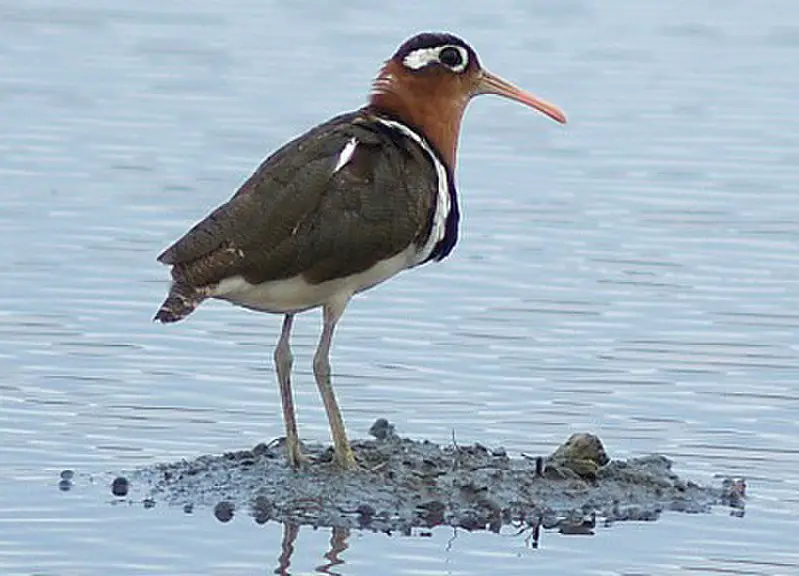
Painted snipes are beautiful and unique wading birds found in the Rostratulidae family. They have short legs, long bills, and a striking plumage which distinguishes them from true snipes.
Males tend to be smaller than females with duller overall coloration. There are three species of painted snipe.
The Greater Painted Snipe, Lesser Painted Snipe, and Australian Painted Snipe – all three have different habitats ranging from wetland pools to grasslands or mangroves depending on their region.
These birds feed mainly on earthworms but also consume insects, crustaceans and plant material when available.
As they rely heavily on wetlands for breeding purposes it is important that we protect these precious habitats so that this special bird can continue to thrive.Scientific classification:
| Kingdom | Animalia |
| Phylum | Chordata |
| Class | Aves |
| Order | Charadriiformes |
| Suborder | Thinocori |
| Family | Rostratulidae Coues, 1888 |
Also Featured In: Most Common Birds in China, Most Common Taiwan Birds
2. Plovers

Plovers are a family of around 64-68 species of ground-dwelling birds, commonly found in open country such as fields, meadows and tundras.
They have short bills with webbed feet to help them forage through mud or shallow water.
Plover plumage is usually mottled brown though some species may have brighter colors on the head and wings.
These birds feed mainly on insects but can also eat small crustaceans and worms.
Plovers breed during springtime when they dig holes in sandy or pebbled beaches to lay their eggs which hatch after about 3 weeks incubation period.
They use distraction display behaviour by pretending an injury to the predators away from their nests if needed for protecting their young ones.Scientific classification:
| Kingdom | Animalia |
| Phylum | Chordata |
| Class | Aves |
| Order | Charadriiformes |
| Family | Charadriidae Leach, 1820 |
Also Featured In: Turkey Birds You Should Know, Common Uzbekistan Birds
3. Glareolidae
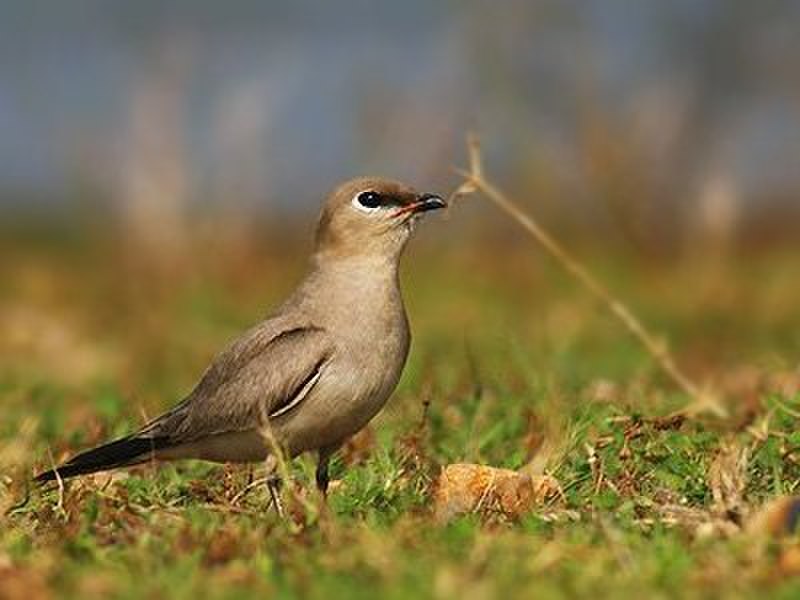
Glareolidae is a family of wading birds, consisting of four genera and 17 species. They are distinguished from other charadrii by their long bills which have a slight downward curve.
Glareolidae live around open grasslands and deserts, where they hunt for insects using the bill to probe into soil or vegetation.
Most species are found in Africa but two pratincoles inhabit parts of Europe and Asia as well.
Coursers tend to be larger than pratincoles with longer legs allowing them to run quickly across sandy dunes while feeding on small animals like lizards or spiders.
Pratincoles feed mainly on flying insects, snatching them out of midair with great agility during flight.
All glareolids share unique features such as large eyes that help it spot prey at night easily making this group one interesting bird family.Scientific classification:
| Kingdom | Animalia |
| Phylum | Chordata |
| Class | Aves |
| Order | Charadriiformes |
| Suborder | Lari |
| Family | Glareolidae CL Brehm, 1831 |
Also Featured In: Common Algerian Birds , Most Common Romanian Birds
4. Bitterns
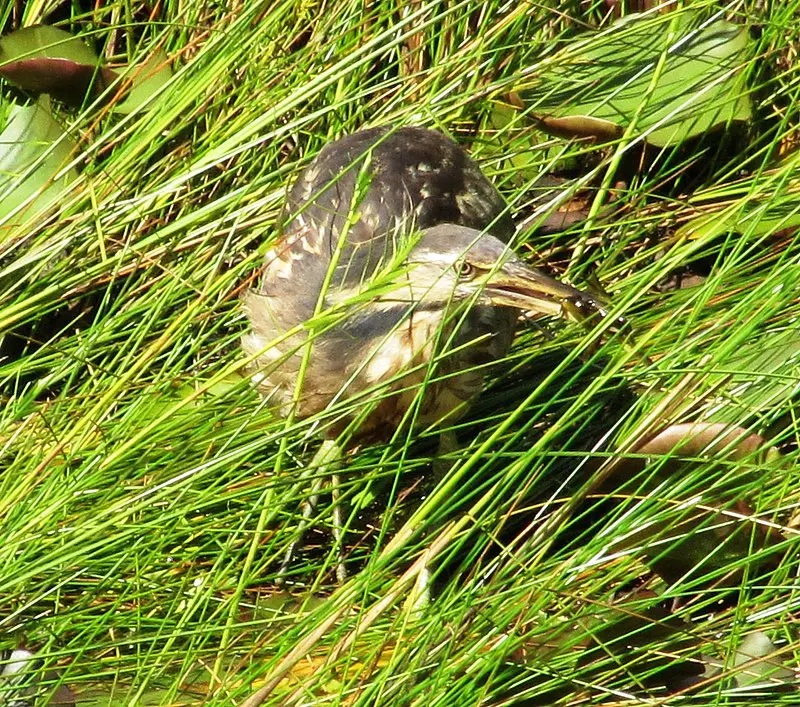
Bitterns are a type of heron, belonging to the Ardeidae family. They have shorter necks and tend to be more secretive than other members of this group.
These birds can usually be found near reed beds or wetlands, where they make their distinctive ‘booming’ call as part of their mating ritual.
Bitterns feed on insects, fish and amphibians which inhabit these areas – catching them with their long pointed bills.
Although bitterns are well camouflaged due to their brown-and-black striped feathers when standing still among reeds, they will fly away quickly if disturbed by humans nearby.Scientific classification:
| Kingdom | Animalia |
| Phylum | Chordata |
| Class | Aves |
| Order | Pelecaniformes |
| Family | Ardeidae |
| Subfamily | Botaurinae Reichenbach, 1850 |
Also Featured In: Birds Found in Hungary, Wetlands Birds You Should Know
5. Bustard
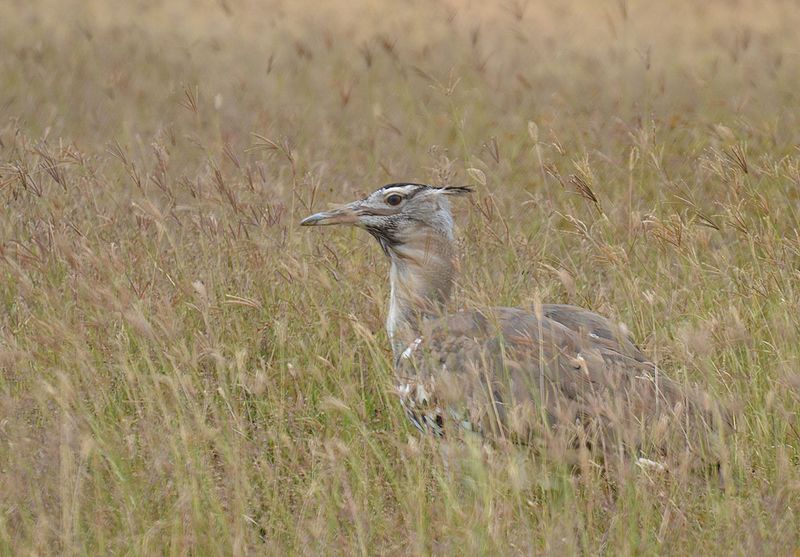
Bustards are large, terrestrial birds that inhabit dry grassland areas and the steppes of the Old World. They range from 40-150 cm in length and belong to the family Otididae.
Bustards have an omnivorous diet consisting of leaves, buds, seeds, fruit as well as small vertebrates and invertebrates.
These birds usually live a solitary life but can be seen gathering around water sources or food during certain times of year such as mating season.
Due to their large size they are vulnerable to predation by foxes or other animals which is why they tend to remain alert at all times.
When in open spaces while relying on camouflage for protection against predators when out in tall vegetation coverings.Scientific classification:
| Kingdom | Animalia |
| Phylum | Chordata |
| Class | Aves |
| Clade | Otidimorphae |
| Order | Otidiformes Wagler, 1830 |
| Family | Otididae Rafinesque, 1815 |
Also Featured In: Common Birds in India, Ukrainian Birds You Should Know
6. Kingfisher
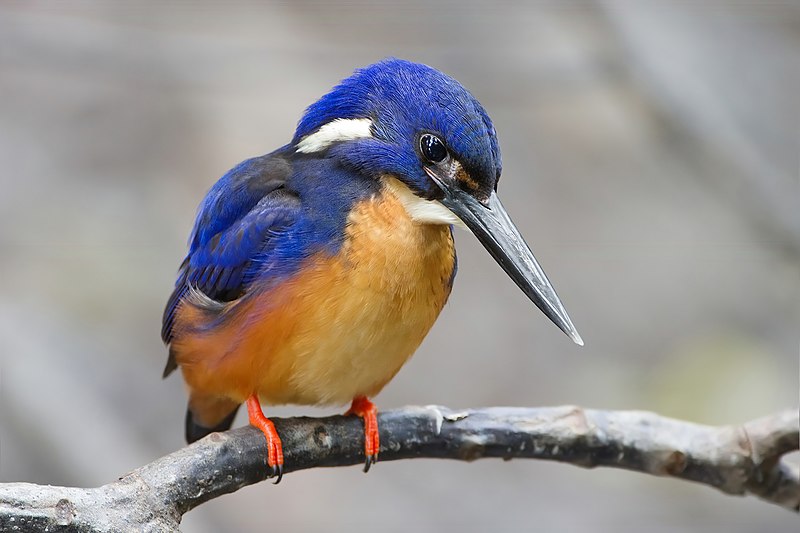
Kingfishers are a vibrant and unique family of birds, with most species found in tropical regions across Africa, Asia, Oceania and Europe.
Their bright colors make them easily identifiable among the foliage of deep forests near calm ponds or rivers.
They come in three subfamilies: tree kingfishers (Halcyoninae), water kingfishers (Cerylinae) and river kingfishers (Alcedinidae).
Kingfisher birds have short legs used for perching along branches overhanging streams or lakes; they also possess strong beaks perfect for catching fish.
These little hunters will remain motionless as if suspended from thin air until an unsuspecting prey comes within reach.
Then they swoop down quickly to grab their meal. With 116 different species making up this incredible family, there’s something special about every single one.Scientific classification:
| Kingdom | Animalia |
| Phylum | Chordata |
| Class | Aves |
| Order | Coraciiformes |
| Suborder | Alcedines |
| Family | Alcedinidae Rafinesque, 1815 |
Also Featured In: Birds You’ll Find in Moldova, African Birds
7. Finches
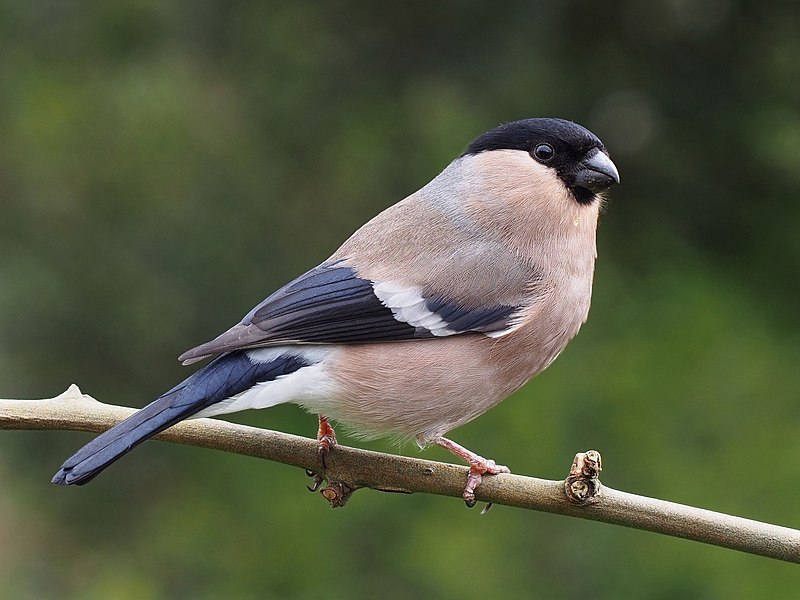
Finches are a diverse group of passerine birds found around the world, excluding Australia and polar regions. They vary in size from small to medium-sized, with stout conical bills adapted for eating seeds and nuts.
Many species have brightly coloured plumage; this helps them stand out against their natural habitats which can range from deserts to forests.
Finches occupy these areas all year round without migrating elsewhere – making them particularly well suited for local environments.
As part of the Fringillidae family they possess unique characteristics that make them popular amongst birdwatchers everywhere.Scientific classification:
| Kingdom | Animalia |
| Phylum | Chordata |
| Class | Aves |
| Order | Passeriformes |
| Superfamily | Passeroidea |
| Family | Fringillidae Leach, 1820 |
Also Featured In: Native Pakistani Birds, Birds for Your Home Garden
8. Jacanas
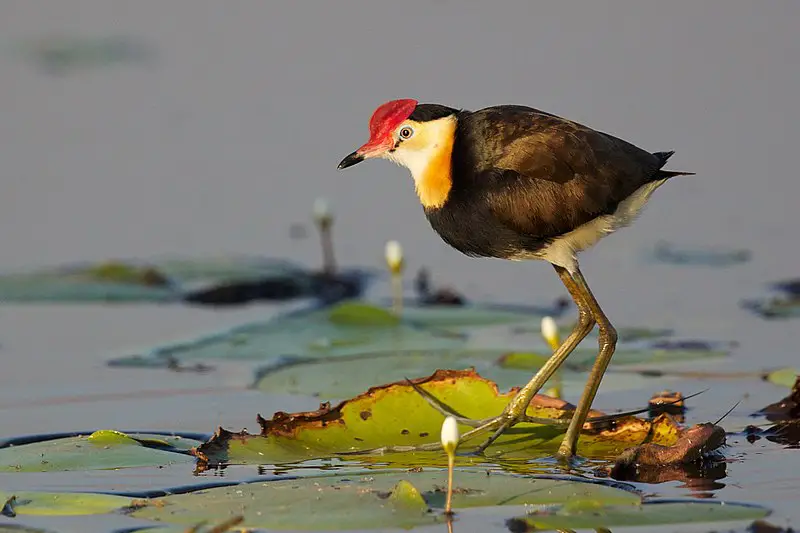
Jacanas are tropical waders belonging to the Jacanidae family. They have distinctive elongated toes and toenails which help them forage on floating or semi-emergent aquatic vegetation.
This adaptation gives them their nickname “Jesus birds” as they seem to be able to walk on water.
The female jacanas are also unique amongst bird species in that they take charge of nest building, incubation and caring for young while males perform courtship displays.
These unusual birds can be found throughout the world’s tropical regions where they inhabit wetlands such as swamps, marshes and shallow lakes with lily pads.
With a wide variety range due their special adaptations these beautiful creatures will surely continue living life at ease around our planet’s warmest waters.Scientific classification:
| Kingdom | Animalia |
| Phylum | Chordata |
| Class | Aves |
| Order | Charadriiformes |
| Suborder | Thinocori |
| Family | Jacanidae Stejneger, 1885 |
Also Featured In: Beautiful Brazilian Birds, Birds that You’ll Find in Puerto Rico
9. Stone-Curlew

Stone-curlews, also known as dikkops or thick-knees, are a family of birds that have adapted to live in tropical and temperate regions throughout the world.
They can be found in Africa, Asia and Australia with two or more species per region. Despite being classified as waders, most prefer dry arid habitats over moist wetlands.
Stone-curlews typically have long legs which help them navigate through their preferred terrain efficiently; some species even stand at an impressive height when standing on those long legs.
Additionally they feature cryptic plumage which helps them blend into their surroundings while hunting for prey such as insects and small mammals like rodents.
These unique bird’s calls are easily recognizable; it has been said that hearing one is similar to listening to someone whistling ‘Keee Weee’.Scientific classification:
| Kingdom | Animalia |
| Phylum | Chordata |
| Class | Aves |
| Order | Charadriiformes |
| Suborder | Chionidi |
| Family | Burhinidae Mathews, 1912 |
Also Featured In: Native Birds of Kazakhstan, Syrian Birds You Need to Know
10. Bee-Eater

Bee-eaters are one of the most beautiful and vibrant birds in existence. They have a slender body, long wings, down turned bills and their signature elongated central tail feathers which make them instantly recognizable from afar.
Their plumage is incredibly colorful with many shades ranging from blues to greens to reds that glisten when they fly through the air.
These stunning creatures can be found all over Africa, Asia, Southern Europe, Australia and New Guinea where they feed mainly on bees but also other insects like flies or wasps as well as small mammals such as lizards or rodents.
Bee-eaters live in colonies near rivers or wetlands so that they may easily hunt for food while staying close together for safety purposes.
Additionally it allows them to better display their impressive courtship dances during mating season.Scientific classification:
| Kingdom | Animalia |
| Phylum | Chordata |
| Class | Aves |
| Order | Coraciiformes |
| Family | Meropidae Rafinesque, 1815 |
Also Featured In: Common Nigerian Birds, Birds of Sweden
11. Olive-Backed Sunbird
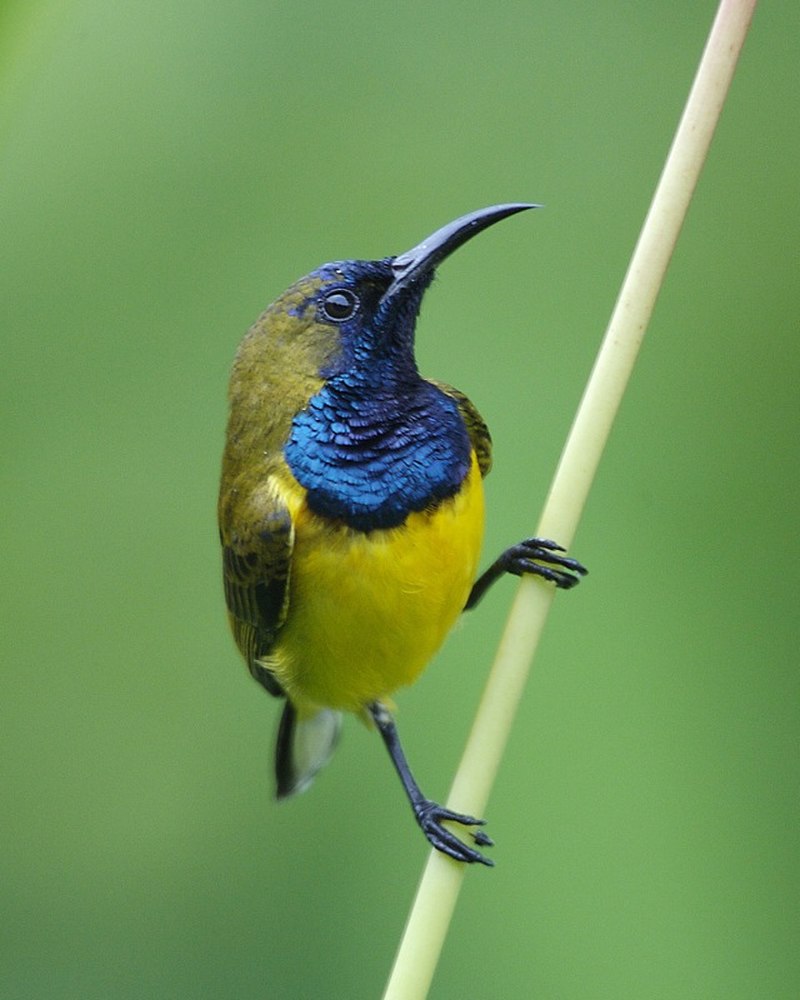
The Olive-backed Sunbird is a vibrant species of sunbird found in Southern Asia and Australia. Its striking yellow underbelly complements its olive upperparts, making it an attractive sight to behold.
First described by Mathurin Jacques Brisson in 1760 based on a specimen from the Philippines, this small songbird loves nectar but will also feed on insects as well as other tiny invertebrates.
It feeds mainly while hovering or perching with its bill pointing downwards – quite an impressive feat.
This bird has adapted to both forested areas and urban gardens meaning they can be seen all over their range.
With conservation efforts in place for this beautiful creature we are sure that the Olive-backed Sunbird will continue to bring joy to our lives for many years yet.Scientific classification:
| Kingdom | Animalia |
| Phylum | Chordata |
| Class | Aves |
| Order | Passeriformes |
| Family | Nectariniidae |
| Genus | Cinnyris |
| Species | C. jugularis |
Also Featured In: Birds of the Philippines, Common Philippines Birds
12. Frogmouth
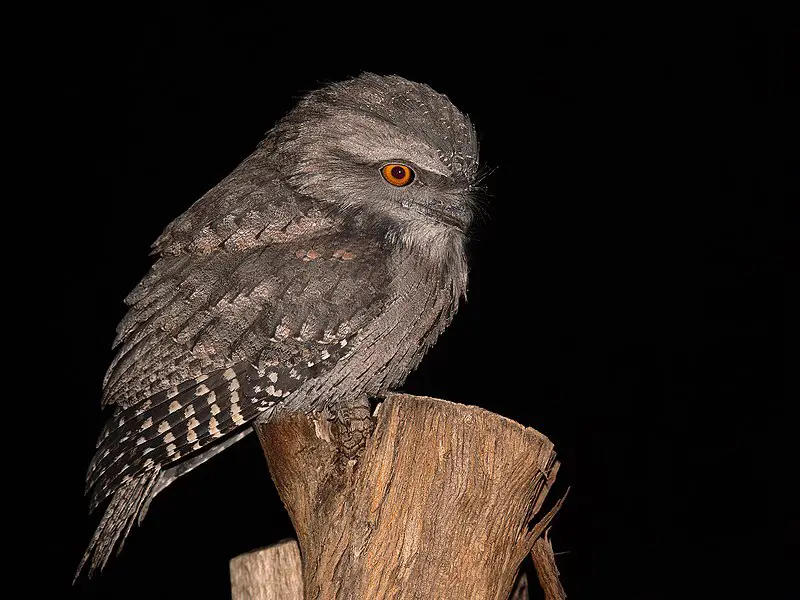
The Frogmouth is a nocturnal bird that belongs to the same family as owlet-nightjars, swifts and hummingbirds.
They have large flattened hooked bills with huge frog-like gape which helps them capture insects during night time.
Three species of Podargus are found in Australia and New Guinea only – they have massive eyes that allow for excellent night vision.
Their bodies are generally grey or brownish in colour with cryptic markings for camouflage when roosting during day light hours.
Generally known as quiet birds, their loud wailing call can be heard at dusk or dawn near river banks or wetlands where they live alone or form pairs throughout breeding season.
The diet of these fascinating creatures consists mainly of flying insects such as moths, beetles & cicadas etc., but on occasion will consume small vertebrates like lizards and frogs too.Scientific classification:
| Kingdom | Animalia |
| Phylum | Chordata |
| Class | Aves |
| Clade | Strisores |
| Order | Podargiformes Matthews, 1918 |
| Family | Podargidae Gray, 1847 |
Also Featured In: Asian Birds, Birds that Charles Darwin Studied
13. Pittas
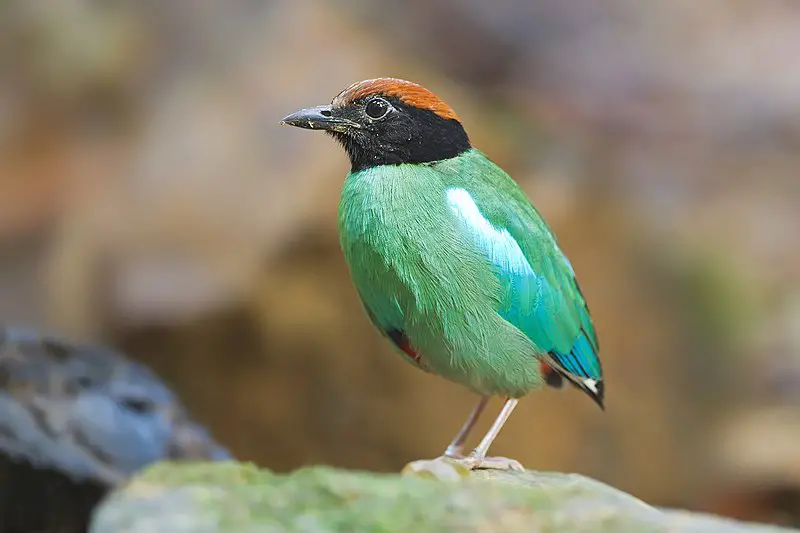
Pittas are a family of passerine birds known for their vibrant colors and unique appearance. They can be found in Asia, Australasia and Africa with around 40 to 42 species existing today.
These Old World suboscines have closest relatives among other bird genera such as Smithornis and Calyptomena.
Pittas inhabit tropical forests where they hop from branch to branch searching for insects or worms on the ground below them.
Their feathers are stunningly colored with combinations of blue, green, copper, purple or even yellow making them stand out amongst others in the forest canopy.Scientific classification:
| Kingdom | Animalia |
| Phylum | Chordata |
| Class | Aves |
| Order | Passeriformes |
| Suborder | Tyranni |
| Infraorder | Eurylaimides |
| Superfamily | Pittoidea |
| Family | Pittidae Authority disputed.[a] |
Also Featured In: Birds of Goa, Birds that Live in Borneo Island
14. Spoonbills
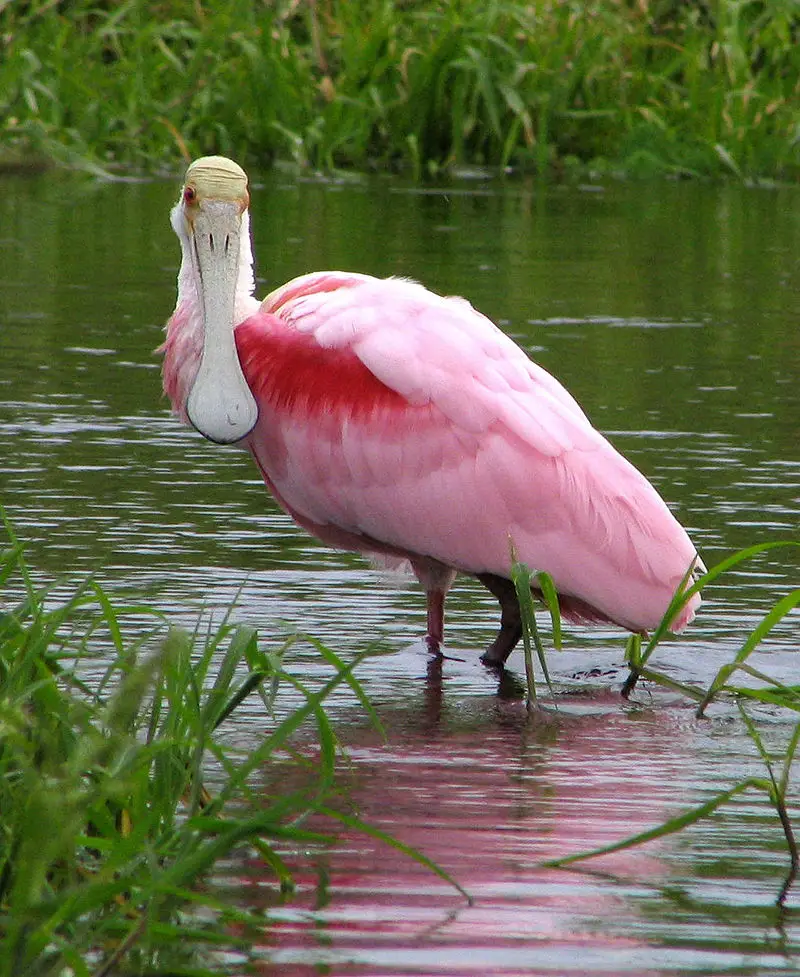
Spoonbills are large wading birds belonging to the genus Platalea. Characterized by their long legs and distinctive spoon-shaped beaks, these birds can be found all over the world except Antarctica.
The name of this genus derives from Ancient Greek meaning “broad”, referring to their bill’s shape.
There are six species of Spoonbill recognized – though they usually form a single group, sometimes it is divided into three genera.
These graceful creatures feed mainly on small aquatic organisms such as insects and fish which they catch with an open-mouth technique while sweeping through shallow waters in search for food.
They typically breed near water bodies during springtime when there’s plenty of food available around them.Scientific classification:
| Kingdom | Animalia |
| Phylum | Chordata |
| Class | Aves |
| Order | Pelecaniformes |
| Family | Threskiornithidae |
| Subfamily | Plataleinae |
| Genus | Platalea Linnaeus, 1758 |
Also Featured In: Birds of South African, Bulgarian Birds
15. Oriental Dollarbird
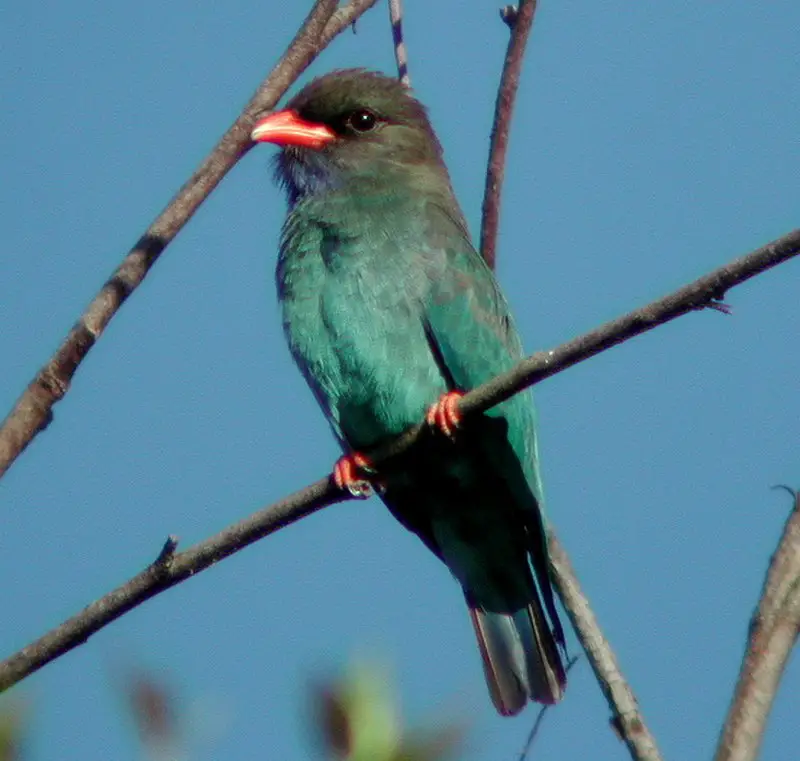
The Oriental dollarbird is a beautiful member of the roller family, easily identified by its pale blue or white coin-shaped spots on its wings.
This species can be found in many places ranging from Australia to Korea, Japan and India.
It was first classified by the Swedish naturalist Carl Linnaeus in 1766 as Coracias orientalis. The bird has an impressive wingspan that helps it soar through the sky with ease.
Its diet consists mainly of insects which it catches mid flight during hunting expeditions for food.
Although shy around people, this mesmerizing creature will fly close enough to humans at times so they can observe them better and appreciate their unique beauty up close.Scientific classification:
| Kingdom | Animalia |
| Phylum | Chordata |
| Class | Aves |
| Order | Coraciiformes |
| Family | Coraciidae |
| Genus | Eurystomus |
| Species | E. orientalis |
Also Featured In: Native South Korean Birds,
16. Falcons And Caracaras
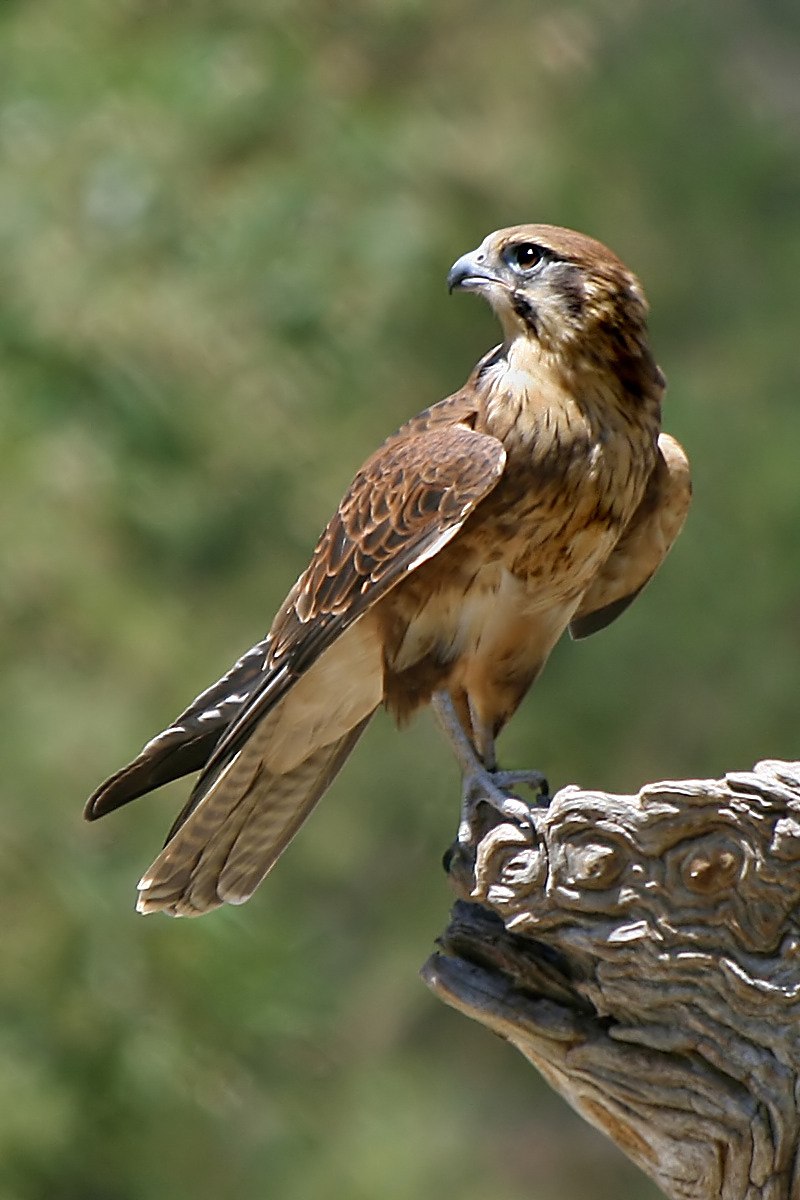
Falcons and caracaras are birds of prey that belong to the family Falconidae. They have impressive sharp talons, hooked beaks and keen eyesight which makes them excellent hunters.
Falcons can reach speeds up to 200 mph when diving for their prey while caracaras use a combination of running and flying to hunt small mammals such as rabbits or rats.
Both falcons and caracaras live in various areas around the world from grasslands, deserts, forests, wetlands or even urban areas where they nest on cliffs or tall buildings.
The diet mainly consists insects but also includes larger animals like reptiles or other birds which they catch by surprise with fast dives out of the sky.Scientific classification:
| Kingdom | Animalia |
| Phylum | Chordata |
| Class | Aves |
| Order | Falconiformes |
| Family | Falconidae Leach, 1820 |
Also Featured In: Italian Birds You Should Know, Lebanon Birds Live in Semi-Desert Areas
17. Buttonquail
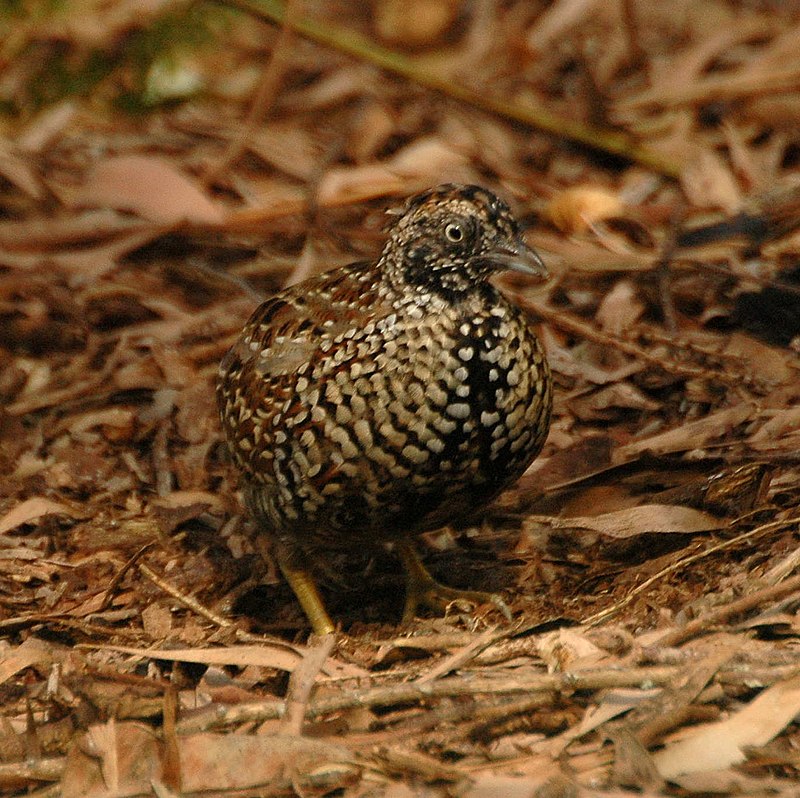
Buttonquails are small, terrestrial birds belonging to the family Turnicidae. They can be found in warm grasslands of Asia, Africa, Europe and Australia.
There are 18 species found across two genera; most being placed under the genus Turnix with a single species known as Ortyxelos.
These birds share a superficial resemblance to quail from Phasianidae but lack any close relation.
Buttonquails avoid flying and instead prefer running on their short legs for navigational purposes.
In terms of physicality they have drab colouring which comprises mostly browns or greys whilst sporting distinctive white patches around their eyes making them easy to identify within dense foliage areas where they usually hide away during times of danger or distress.Scientific classification:
| Kingdom | Animalia |
| Phylum | Chordata |
| Class | Aves |
| Order | Charadriiformes |
| Family | Turnicidae GR Gray, 1840 |
Also Featured In: Birds of Morocco, Hong Kong Birds You Need to See
18. Guineafowls
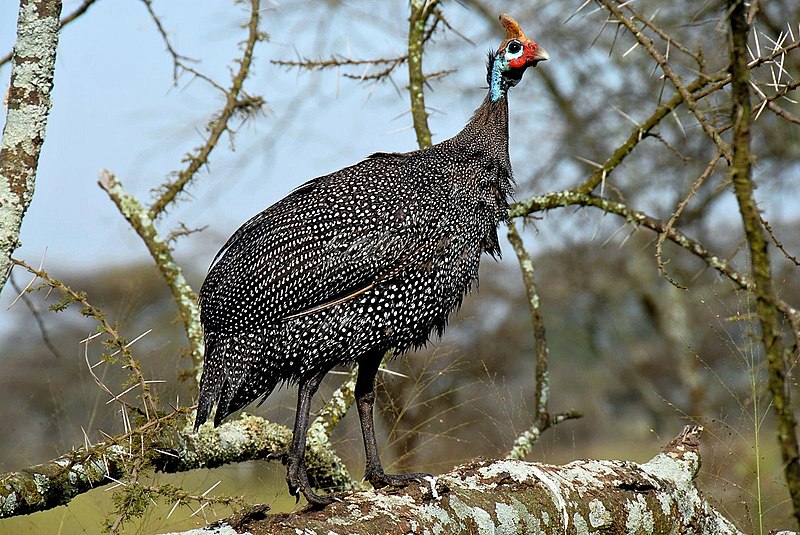
Guineafowls are a family of birds native to Africa and one of the oldest types of Galliformes. They have speckled feathers, long wattles on their necks, and small heads with bright red eyes.
These birds prefer open woodlands or savannas where they can feed on insects, seeds, berries and other forms of vegetation. A mature guineafowl can weigh up to 4 lbs., making them some of the largest members in the Numididae bird family.
Guineafowls use loud calls as a form communication between each other during breeding season when they gather together in large flocks for protection from predators such as hawks and humans which hunt them for food or sport.
Though not endangered yet this species is vulnerable due to habitat destruction so it’s important we protect these interesting animals that have been around since before recorded history.Scientific classification:
| Kingdom | Animalia |
| Phylum | Chordata |
| Class | Aves |
| Order | Galliformes |
| Superfamily | Phasianoidea |
| Family | Numididae Longchamps, 1842 |
Also Featured In: Common Birds in Saudi Arabian, Small Birds that Live in New South Wales
19. Honeyeaters
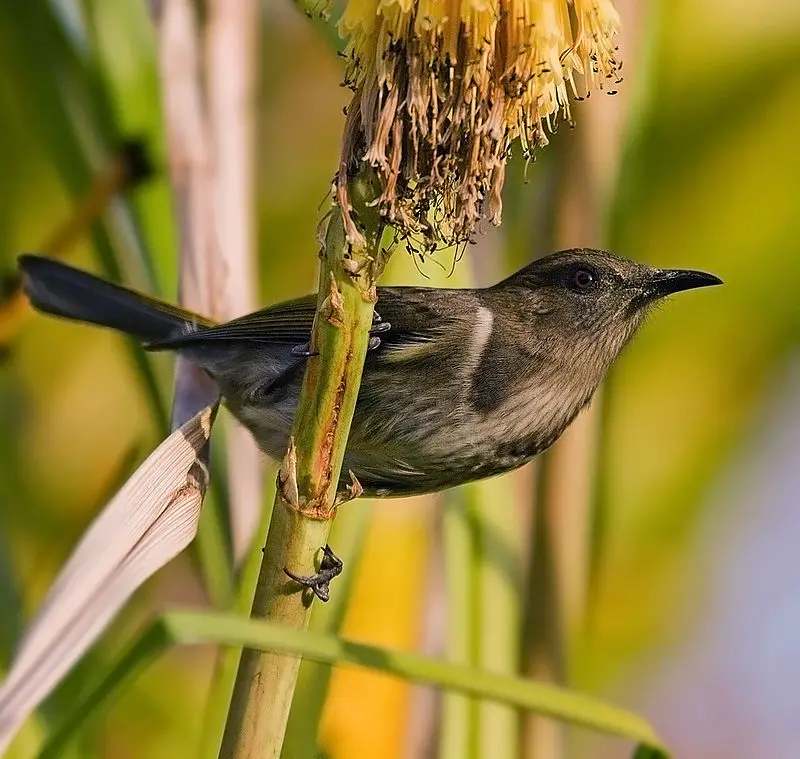
Honeyeaters are a unique and diverse family of birds, with species ranging in size from small to medium.
Found mainly in Australia and New Guinea, they can also be found as far east as Samoa and Tonga, or on islands such as Wallacea north or west of New Guinea.
Honeyeaters feed mainly on nectar but will consume insects if necessary for additional nutrition. They have specialized brush-like tongues that help them extract the nectar efficiently.
Their bright colours tend to make them stand out among other bird families making them easy to spot when out observing wildlife.Scientific classification:
| Kingdom | Animalia |
| Phylum | Chordata |
| Class | Aves |
| Order | Passeriformes |
| Superfamily | Meliphagoidea |
| Family | Meliphagidae Vigors, 1825 |
Also Featured In: Most common birds in Australia, Guam Birds You Need to See
20. Laughing Kookaburra
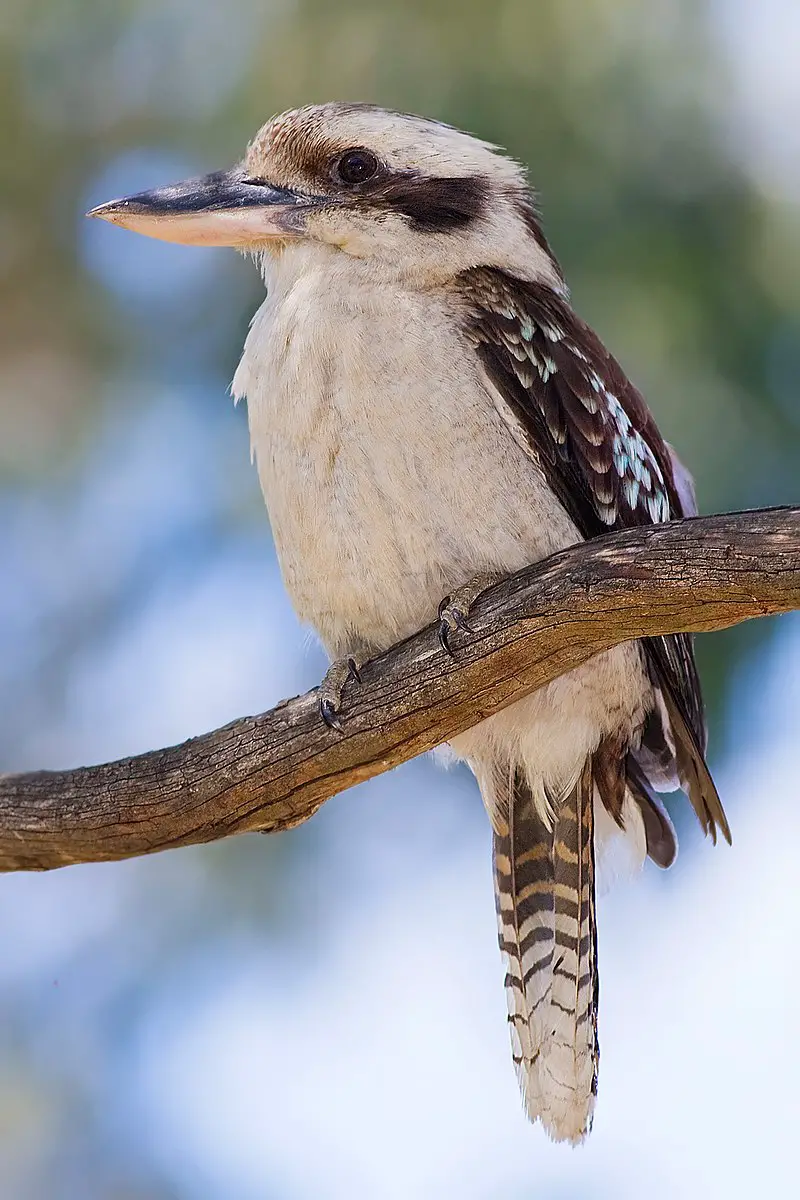
The Laughing Kookaburra is a beautiful bird with distinct features. It has a whitish head and brown eye-stripe, along with an upper body that is predominantly dark brown.
On its wings are mottled light blue patches which make it stand out even more. Its underparts are cream white while its tail is barred in rufous and black colours.
Male and female birds have the same plumage, making them easy to identify as belonging to this species of kingfisher subfamily Halcyoninae.
They can be found living around woodlands or open forests throughout eastern Australia, where they feed on small reptiles, insects or amphibians by swooping down from a perch above them before carrying their prey back up again for consumption.
The sound of their loud distinctive call – “koo-kaa-brrr” – brings joy to many Australians who appreciate these wonderful creatures inhabiting our landScientific classification:
| Kingdom | Animalia |
| Phylum | Chordata |
| Class | Aves |
| Order | Coraciiformes |
| Family | Alcedinidae |
| Subfamily | Halcyoninae |
| Genus | Dacelo |
| Species | D. novaeguineae |
Also Featured In: Birds You’ll Find in Zoo, Birds Typically Found in Australian Rainforest
21. Rainbow Lorikeet
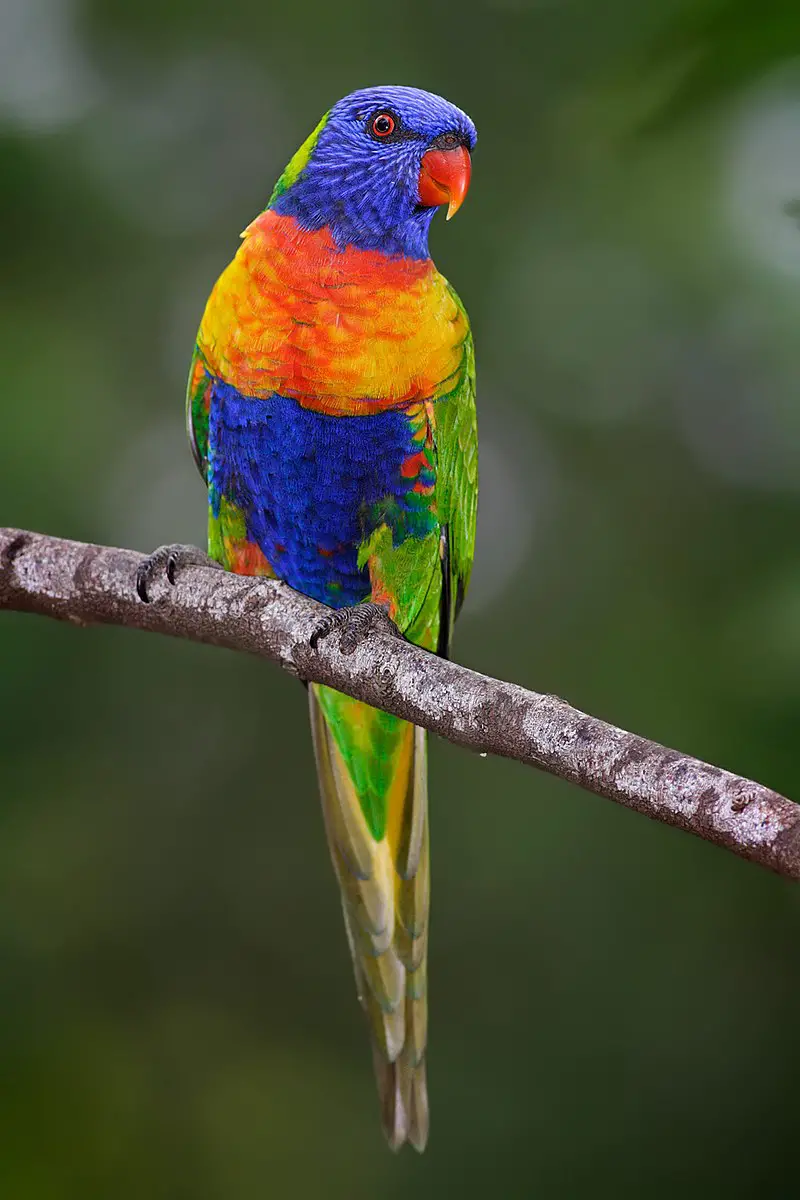
The Rainbow Lorikeet is a brightly coloured parrot native to Australia. It inhabits rainforests, coastal bushlands and woodland areas along the eastern seaboard from northern Queensland to South Australia.
These birds have an unmistakable bright rainbow plumage of blue, red and yellow feathers which make them easy to recognise in their natural environment.
They are also known for their distinctive call – often described as sounding like ‘kikiki-kyu’.
Six related species were once considered subspecies of the Rainbow Lorikeet but these days they are recognised separately due to differences in size, colouration and behaviour.
Despite being introduced elsewhere such as New Zealand, Hawaii or California they remain largely confined within their original range in Australia – where they can be seen soaring through the air or drinking nectar from flowers with its long tongue.Scientific classification:
| Kingdom | Animalia |
| Phylum | Chordata |
| Class | Aves |
| Order | Psittaciformes |
| Family | Psittaculidae |
| Genus | Trichoglossus |
| Species | T. moluccanus |
Also Featured In: Aviary Birds You Should Know, Birds that Live Near Adelaide
22. Australian King Parrot
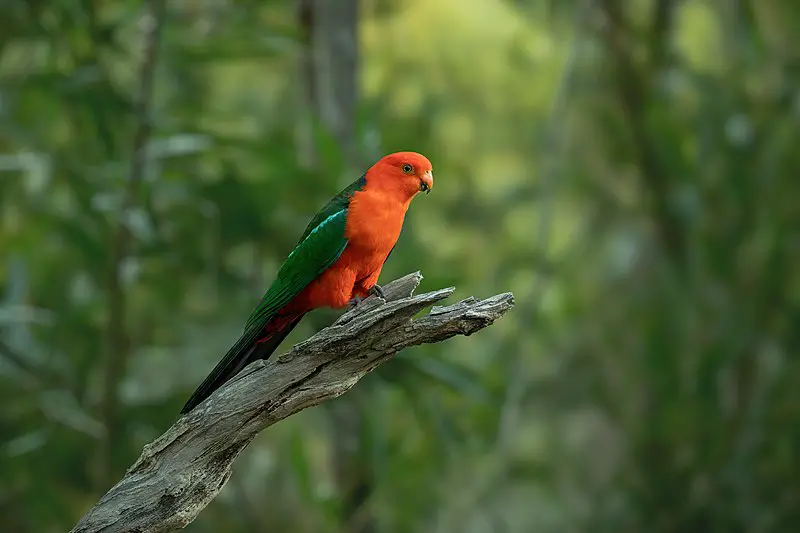
The Australian king parrot is a colourful bird endemic to eastern Australia. It lives in humid, heavily forested areas of the continent including eucalyptus woodlands and subtropical and temperate rainforest.
The King Parrot has an unmistakable green back with red underparts for males, females show more muted colours but still have a bright red belly.
These birds feed on fruits and seeds gathered from trees or shrubs such as Eucalyptus, Acacia or Lillipilli.
They are also commonly seen scavenging for food near roadsides where people often leave scraps behind – so it pays to be careful if you’re driving through any areas they inhabit.
Despite their small size these birds are quite vocal making them easily noticed by both humans and other wildlife alike.Scientific classification:
| Kingdom | Animalia |
| Phylum | Chordata |
| Class | Aves |
| Order | Psittaciformes |
| Family | Psittaculidae |
| Genus | Alisterus |
| Species | A. scapularis |
23. Bowerbirds
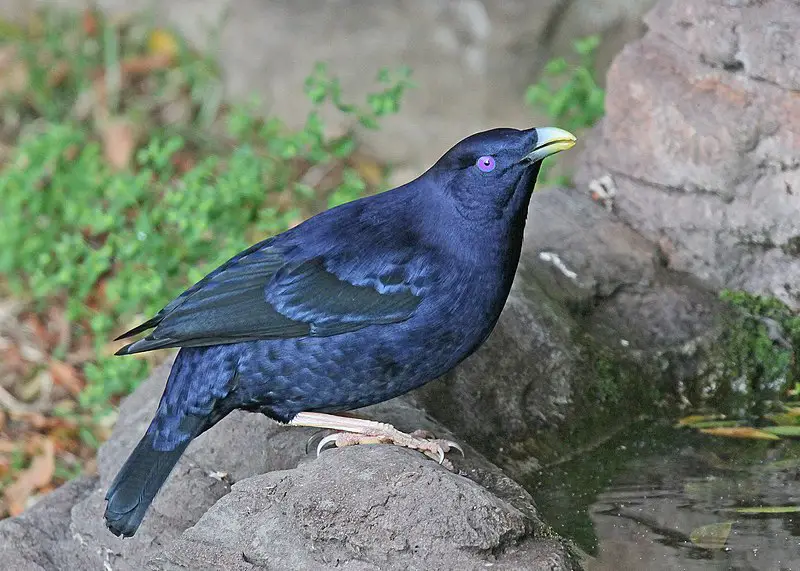
Bowerbirds are a fascinating group of birds belonging to the Ptilonorhynchidae family. They have an incredible courtship display, where males build elaborate structures and decorate them with bright objects in order to attract a mate.
There are 27 species found within 8 genera, ranging from 22 cm (8.7 in) long Golden Bowerbird to larger passerines weighing up to 70 g.
Their diet consists mainly of fruit and insects as well as nectar on occasion depending upon their habitat range.
These beautiful creatures can be found inhabiting rainforests across Australia, New Guinea and Indonesia – all areas that boast lush vegetation for these birds’ unique nesting requirements.Scientific classification:
| Kingdom | Animalia |
| Phylum | Chordata |
| Class | Aves |
| Order | Passeriformes |
| Clade | Eupasseres |
| Suborder | Passeri |
| Family | Ptilonorhynchidae GR Gray, 1841 |
Also Featured In: Flocks Birds around Us,
24. Sulphur-Crested Cockatoo
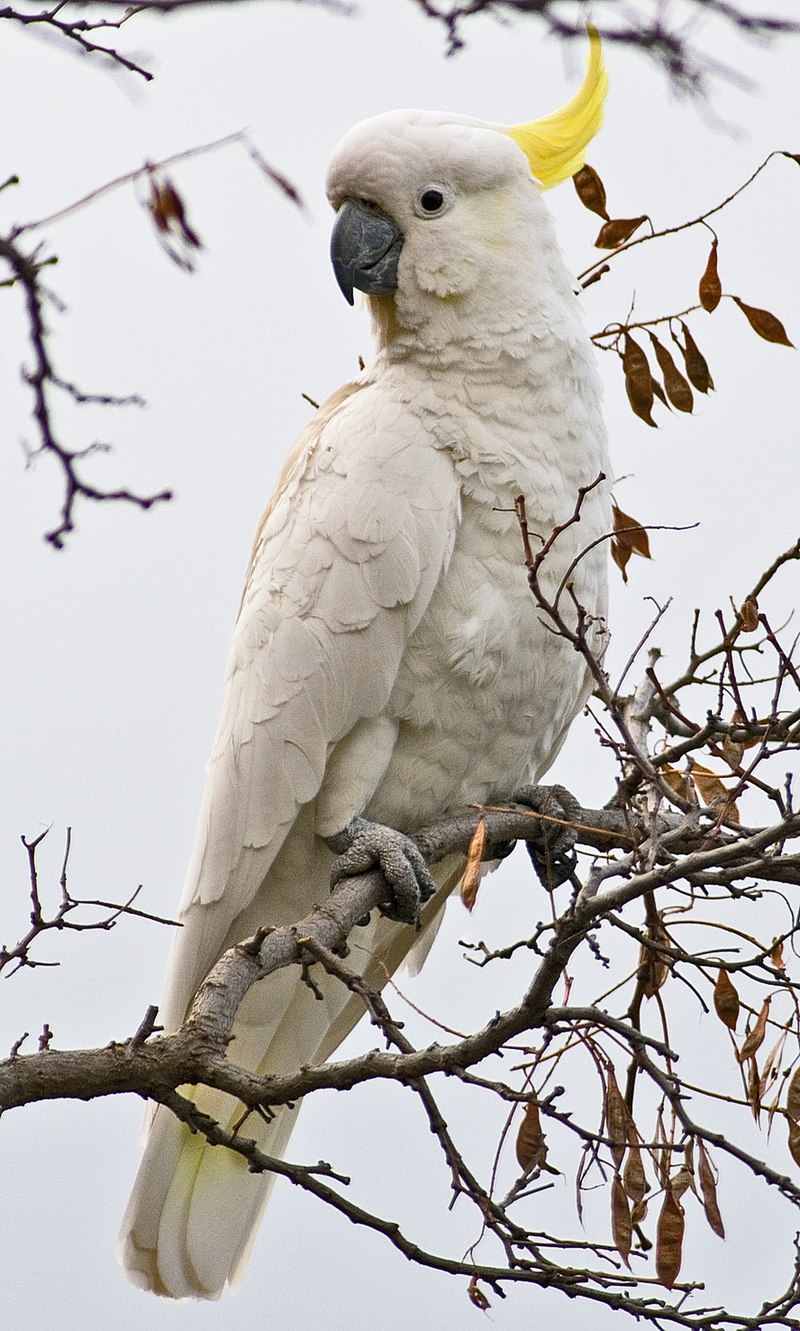
The Sulphur-crested Cockatoo (Cacatua galerita) is a white, relatively large cockatoo native to Australia, New Guinea and some of the islands in Indonesia.
They are highly intelligent birds with distinctive yellow crests on their heads.
These beautiful creatures can be found living in wooded habitats where they often form large flocks that sometimes cause problems as they become pests.
In aviculture, these parrots are very popular due to their intelligence and lively nature but it should be noted that they require an experienced birdkeeper or owner to properly take care of them since they can also be quite demanding pets at times.
All in all though, the Sulphur-crested Cockatoos remain one of the most beloved species among bird enthusiasts around the world.Scientific classification:
| Kingdom | Animalia |
| Phylum | Chordata |
| Class | Aves |
| Order | Psittaciformes |
| Family | Cacatuidae |
| Genus | Cacatua |
| Subgenus | Cacatua |
| Species | C. galerita |
25. Superb Fairywren
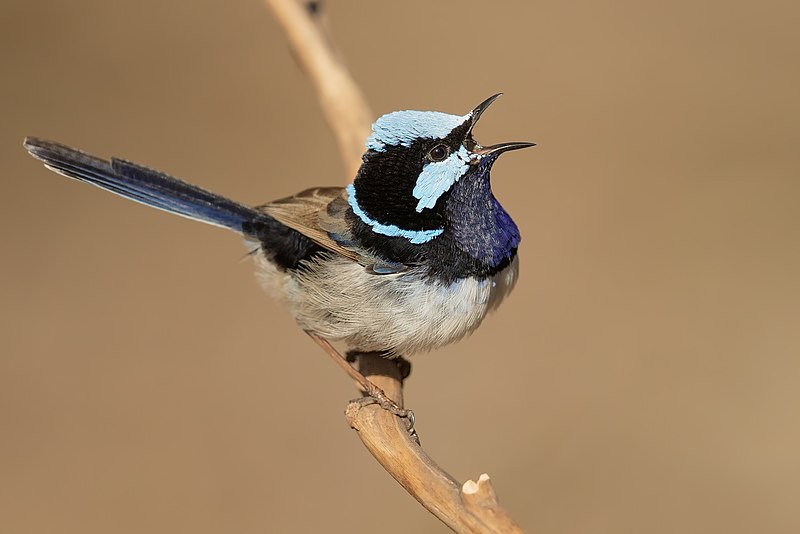
The Superb Fairywren is a beautiful and unique bird native to southeastern Australia.
The male in breeding plumage has an impressive bright blue forehead, ear coverts, mantle and tail with a black mask and either black or dark blue throat.
They are sedentary birds that form strong territorial bonds with their mates; the males staying close-by while the females build nests away from them.
These birds exhibit high sexual dimorphism; making it easy for us to distinguish between males and females of this species.
Their diet consists primarily of insects although they will also feed on other invertebrates as well as nectar, fruit and seeds when available.
This small passerine bird is sure to bring any garden alive with its vibrant colours.Scientific classification:
| Kingdom | Animalia |
| Phylum | Chordata |
| Class | Aves |
| Order | Passeriformes |
| Family | Maluridae |
| Genus | Malurus |
| Species | M. cyaneus |
Also Featured In: Birds that Live in Kangaroo Island,
26. Rainbow Bee-Eater
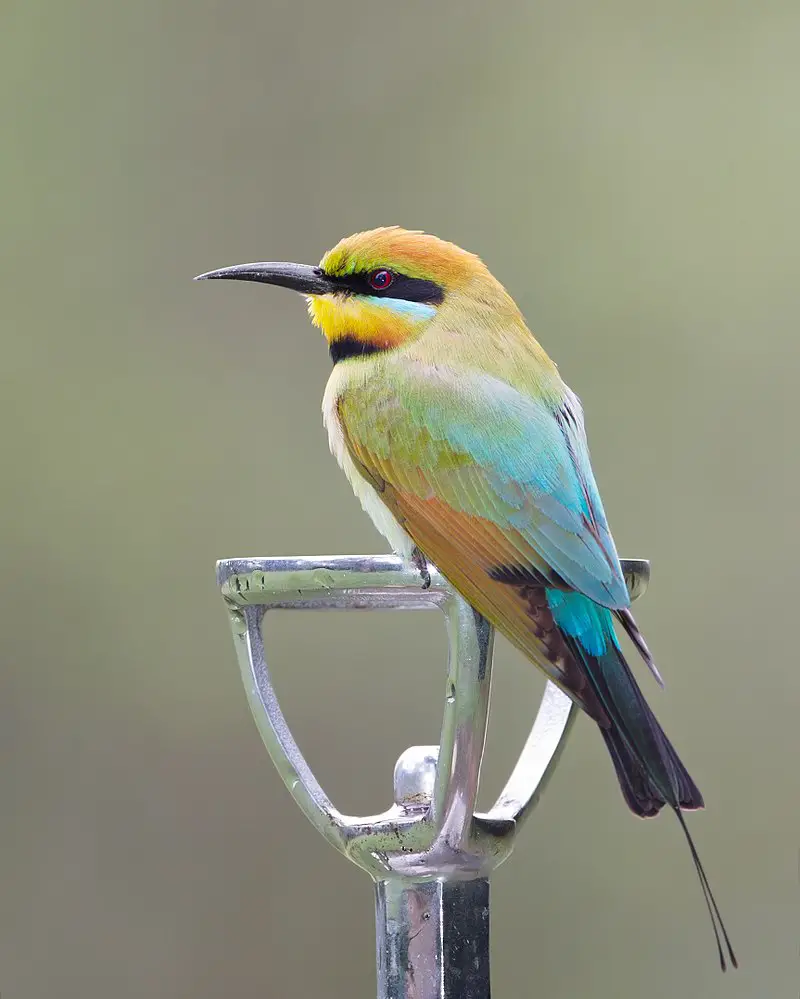
The Rainbow bee-eater (Merops ornatus) is a delightful near passerine bird belonging to the bee-eater family Meropidae.
It is found exclusively in Australia, making it one of only two species of its kind throughout the world; its closest relative being located in Southern and Eastern Africa – the olive bee-eater (Merops superciliosus).
Its stunning plumage features a unique palette of colours including shades pinkish reds, blues, greens and yellows which make for an impressive display when seen up close.
Due to their diet consisting mainly on bees and other insects they have adapted specialised beaks with serrated edges that allow them to easily capture their prey mid flight.
A truly remarkable sight indeed.Scientific classification:
| Kingdom | Animalia |
| Phylum | Chordata |
| Class | Aves |
| Order | Coraciiformes |
| Family | Meropidae |
| Genus | Merops |
| Species | M. ornatus |
Also Featured In: Birds of Far North Queensland, Common Townsville Birds
27. Crested Pigeon
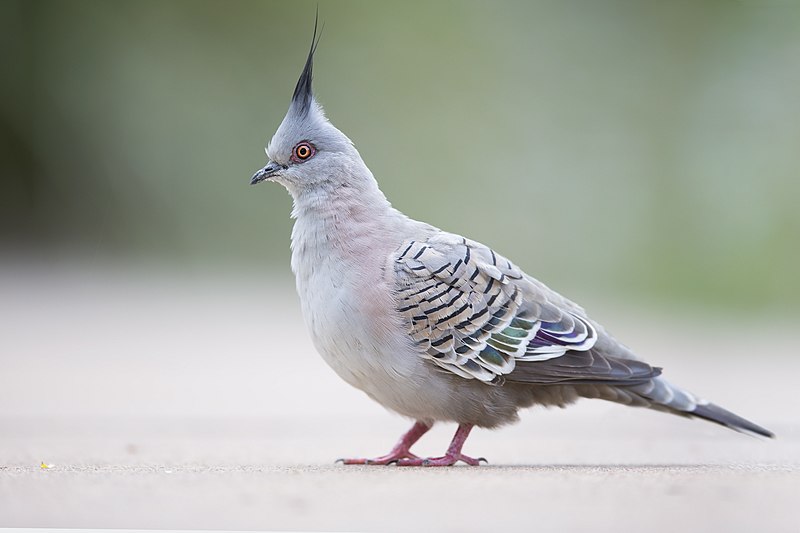
The Crested Pigeon is a medium-sized bird found widely across mainland Australia. It stands out from other pigeons due to its unique erect crest on the top of its head, which gives it an unmistakable look.
The body of this pigeon is slate grey in color with lighter gray undersides and chestnut colored wings that have white tips when they are open while flying.
Its striking black tipped yellow beak and pale blue eye ring add further interest to this beautiful species.
When alarmed, these birds will make loud clapping sounds by bringing their wings together above their backs as part of their defensive behavior.Scientific classification:
| Kingdom | Animalia |
| Phylum | Chordata |
| Class | Aves |
| Order | Columbiformes |
| Family | Columbidae |
| Genus | Ocyphaps G.R. Gray, 1842 |
| Species | O. lophotes |
Also Featured In: Most Common Birds in Oceania,
28. Pheasant Coucal
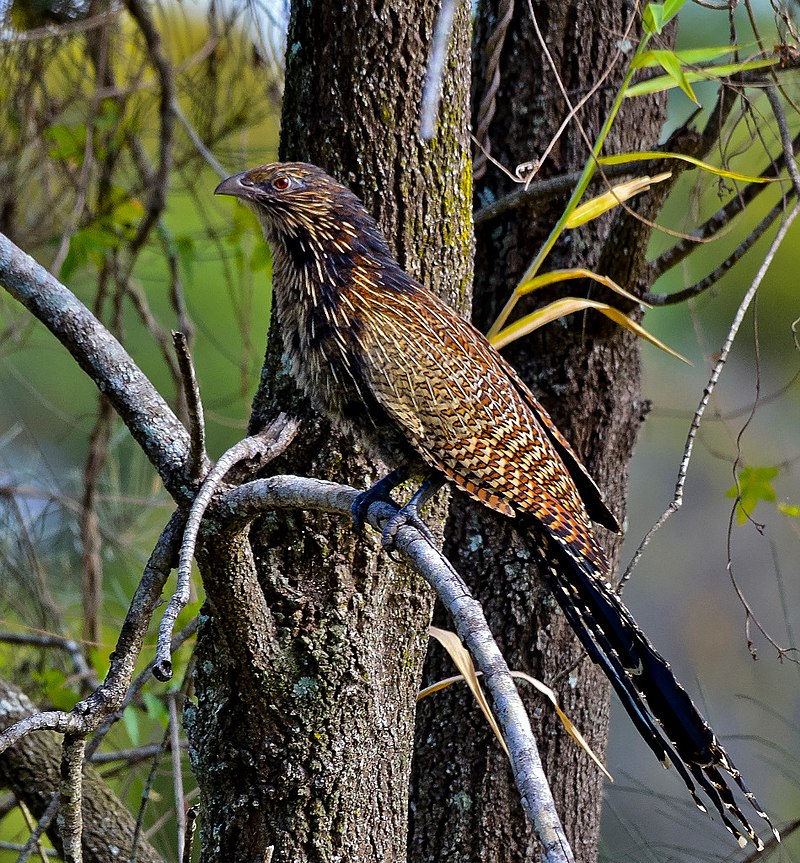
The Pheasant Coucal is a species of cuckoo native to Australia, Timor and New Guinea.
It can be found in subtropical or tropical moist lowland forests as well as mangrove forests but has also adapted well to agricultural areas such as cane fields in Northern Australia.
This makes it an unusual bird among the Australian cuckoos since unlike most other birds from this family, it doesn’t rely on its hosts for incubation and raising offsprings – instead, it does all that by itself.
The female typically lays three eggs which are oval-shaped with light blue colouring that fades over time.
Pheasant coucals have dark brown feathers with some lighter markings around their necks and wings making them look quite unique compared to other birds within the same family.Scientific classification:
| Kingdom | Animalia |
| Phylum | Chordata |
| Class | Aves |
| Order | Cuculiformes |
| Family | Cuculidae |
| Genus | Centropus |
| Species | C. phasianinus |
Also Featured In: Native Birds Of Mackay,
29. Noisy Miner
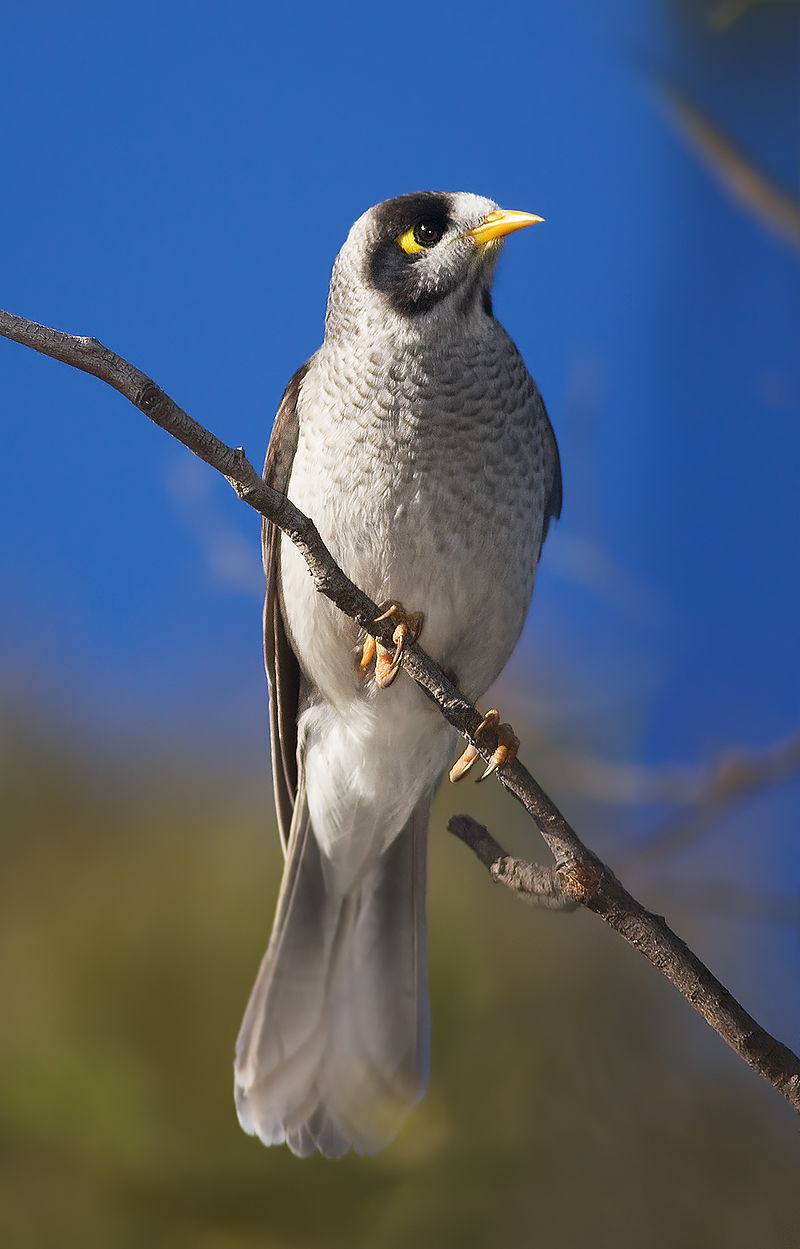
The Noisy Miner is a beautiful bird native to eastern and southeastern Australia. It has a grey body, black head, orange-yellow beak and feet, with an eye patch that ranges from yellow to more intense in Tasmanian birds.
The tail feathers are distinguished by white tips which provide it with its signature look. These miners have the ability to produce loud calls when communicating or defending their territory – hence their name.
They mainly feed on fruit but also insects, nectar and small lizards found around gardens.
As they are quite common in urban areas of Australia, these birds make for some delightful avian visitors.Scientific classification:
| Kingdom | Animalia |
| Phylum | Chordata |
| Class | Aves |
| Order | Passeriformes |
| Family | Meliphagidae |
| Genus | Manorina |
| Species | M. melanocephala |
30. Bush Stone-Curlew
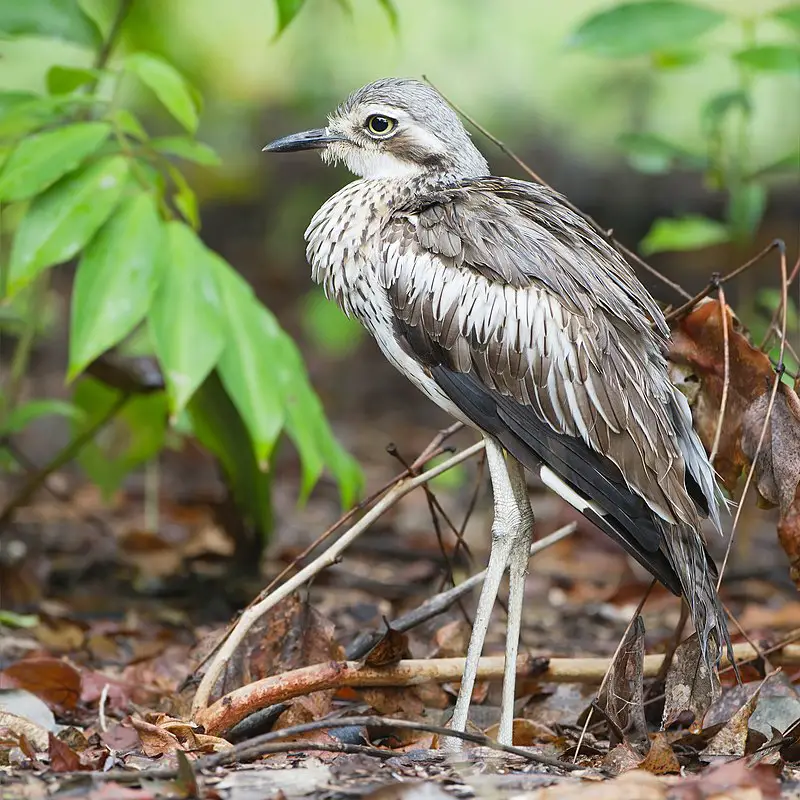
The Bush Stone-Curlew, also known as the Iben Bird, is an endemic species of Australia found in open plains and woodlands. It has grey-brown coloration with dark streaks and large eyes, making it easy to identify.
During night time this bird looks for invertebrates such as insects by slowly stalking its prey. Its long legs allow it to easily traverse across vast landscapes while hunting for food.
The Bush Stone-Curlew plays a vital role in maintaining balance within the ecosystem through controlling insect population growth which can be damaging if not monitored carefully.
Unfortunately due to human interference this species has become endangered so all efforts should be made towards conserving them before they are lost forever from our planet’s biodiversity.Scientific classification:
| Kingdom | Animalia |
| Phylum | Chordata |
| Class | Aves |
| Order | Charadriiformes |
| Family | Burhinidae |
| Genus | Burhinus |
| Species | B. grallarius |
31. Major Mitchell’s Cockatoo
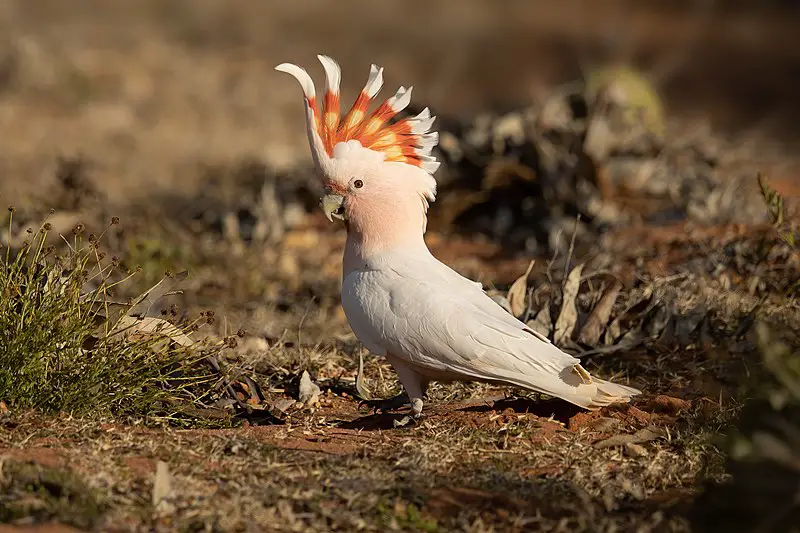
The Major Mitchell’s cockatoo is a medium-sized bird native to arid and semi-arid regions of Australia. It has been seen in other climates, such as South-East Queensland’s subtropical region.
The species was first described by Irish naturalist Nicholas Aylward Vigors in 1831 under the name Plyctolophus leadbeateri.
This pink cockatoo has distinctive grey downy feathers on its back and wings which contrast with its snowy white head, chest and tail feathers.
Its red crest stands out against the otherwise monochrome body when it spreads open during displays of excitement or aggression.
Despite being quite rare, these birds are hardy survivors that can live up to 80 years if given proper care and nutrition.Scientific classification:
| Kingdom | Animalia |
| Phylum | Chordata |
| Class | Aves |
| Order | Psittaciformes |
| Family | Cacatuidae |
| Genus | Lophochroa Bonaparte, 1857 |
| Species | L. leadbeateri |
Also Featured In: Famous Paintings Birds,
32. Masked Lapwing
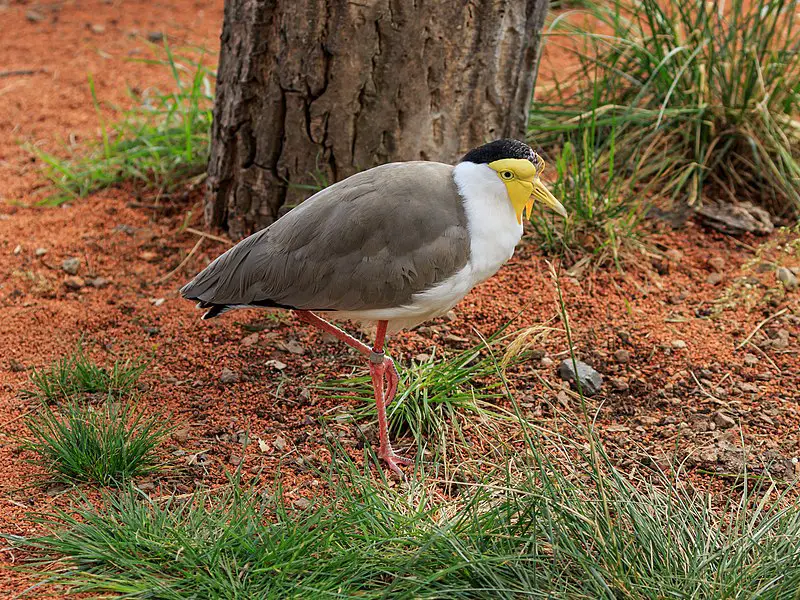
The Masked Lapwing is a large, distinctive bird that can be found in Australia, New Zealand and parts of Papua New Guinea.
It spends most of its time on the ground searching for food such as insects and worms, making it an important part of the local ecology.
It has several loud calls that are easily recognisable – from its ‘kwee-ep’ alarm call to its territorial ‘chi-wick’ call.
The Masked Lapwing is particularly known for swooping down when disturbed or threatened; however this behaviour serves to protect their nests with chicks during breeding season.
They inhabit open fields and grasslands which makes them easy to see if you’re lucky enough.Scientific classification:
| Kingdom | Animalia |
| Phylum | Chordata |
| Class | Aves |
| Order | Charadriiformes |
| Family | Charadriidae |
| Genus | Vanellus |
| Species | V. miles |
33. Megapode
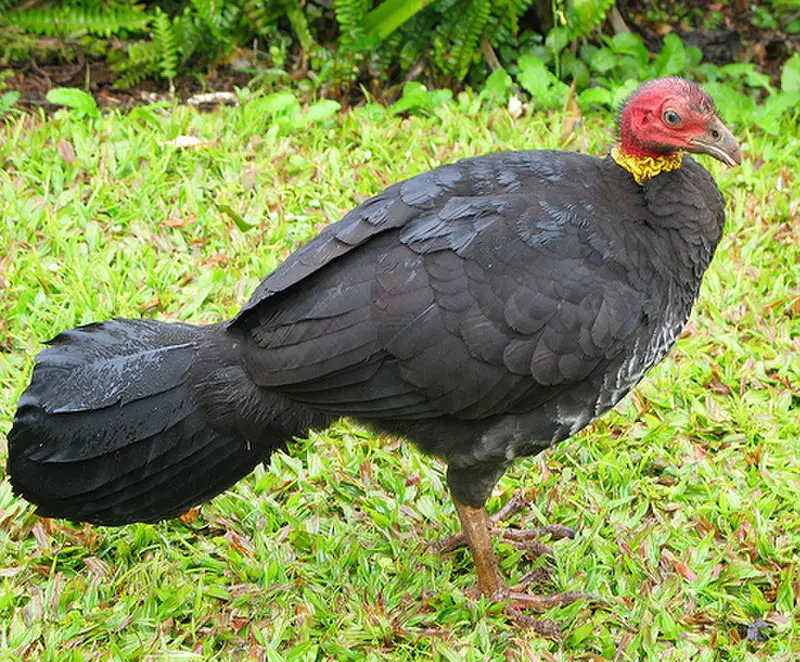
Megapodes are a unique family of birds with large feet and small heads. They measure from medium-large in size, similar to chickens, and have either brown or black feathers covering their bodies.
These terrestrial creatures live mainly in wooded areas where they browse for food like fruits and insects.
With the exception of the Malleefowl species, all Megapodes build mounds which act as incubators for them to lay eggs on – hence why they’re also known as “incubator birds”.
Thanks to this adaptation, these unusual animals can survive extreme temperatures by relying on heat generated from composting material beneath them instead of sitting directly atop their eggs.Scientific classification:
| Kingdom | Animalia |
| Phylum | Chordata |
| Class | Aves |
| Order | Galliformes |
| Family | Megapodiidae Lesson, 1831 |
Also Featured In: Papua New Guinea birds,
34. Magpie Goose
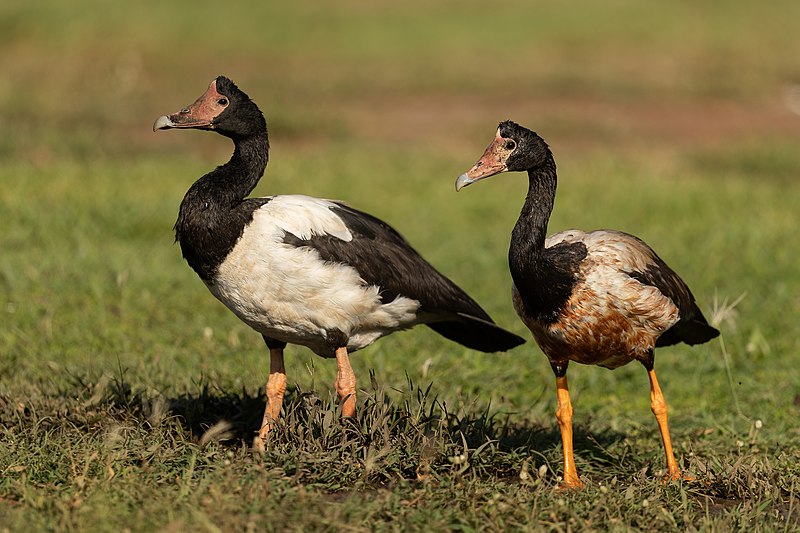
The Magpie Goose is a unique waterbird native to northern Australia and southern New Guinea. It can sometimes be found outside its range due to wandering, but was once widespread in southern Australia until it disappeared.
This species has a distinctive black-and-white plumage with an orange bill and feet which makes them easily recognisable amongst other birds.
They usually live in small flocks around wetlands where they feed on aquatic plants and insects, as well as grain crops when available.
The magpie goose nests near the ground or atop tall vegetation such as reeds or shrubs, laying eggs that are incubated by both parents for up to 30 days before hatching into fluffy yellow goslings.
These beautiful geese have adapted over time so they can survive even during dry periods of their habitats making them an integral part of many wetland ecosystems across Northern Australia and Southern New GuineaScientific classification:
| Kingdom | Animalia |
| Phylum | Chordata |
| Class | Aves |
| Order | Anseriformes |
| Family | Anseranatidae |
| Genus | Anseranas Lesson, 1828 |
| Species | A. semipalmata |
35. Australasian Swamphen
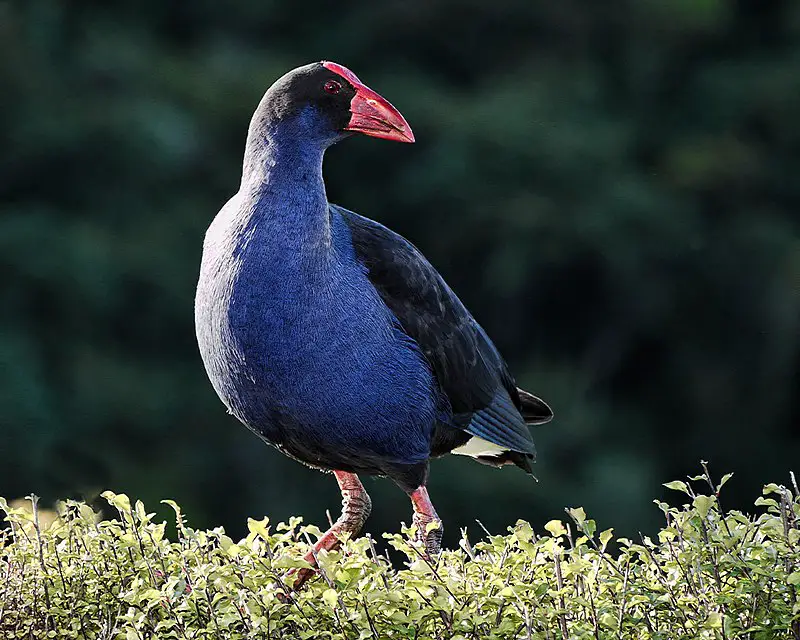
The Australasian swamphen is a species of waterbird found in eastern Indonesia, Papua New Guinea, Australia and New Zealand. In its native lands it’s known as the pukeko by Māori speakers.
It was once thought to be part of the purple swamphen subspecies but has since been classified as distinct from that particular species.
This bird prefers wetland habitats with still or slow-moving waters such as swamps and marshes where they feed on aquatic vegetation like grasses, sedges and rushes while also feasting upon small invertebrates when available.
The males are territorial during breeding season while their chicks will remain near parents until they become independent after two months old.
They’re overall excellent fliers which gives them an advantage against predators looking for easy meals.Scientific classification:
| Kingdom | Animalia |
| Phylum | Chordata |
| Class | Aves |
| Order | Gruiformes |
| Family | Rallidae |
| Genus | Porphyrio |
| Species | P. melanotus |
Also Featured In: New Zealand Birds,
36. Brown Goshawk
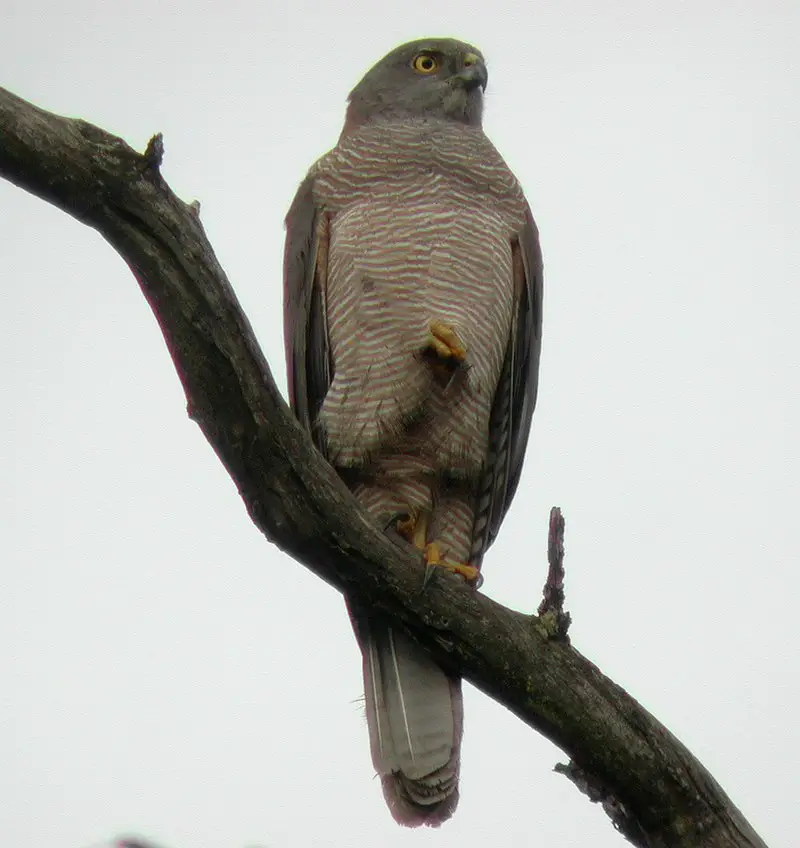
The Brown Goshawk is a medium-sized bird of prey that can be found in Australia and its surrounding islands.
It has grey upperparts with chestnut collar, while the underparts are mainly rufous finely barred with white.
This gives it similar colouring to collared sparrowhawk but it is larger as compared to them; body length being between 40-55 cm.
The flight of this majestic raptor is fast and flexible making for an impressive sight when spotted in the sky.
Its diet consists mostly of small birds, mammals such as rodents or bats, large insects like grasshoppers etc., thus playing an important role in maintaining balance within local ecosystems by controlling population numbers these species.Scientific classification:
| Kingdom | Animalia |
| Phylum | Chordata |
| Class | Aves |
| Order | Accipitriformes |
| Family | Accipitridae |
| Genus | Accipiter |
| Species | A. fasciatus |
Also Featured In: Vanuatu birds, Common Flinders Island Birds
37. Nankeen Kestrel
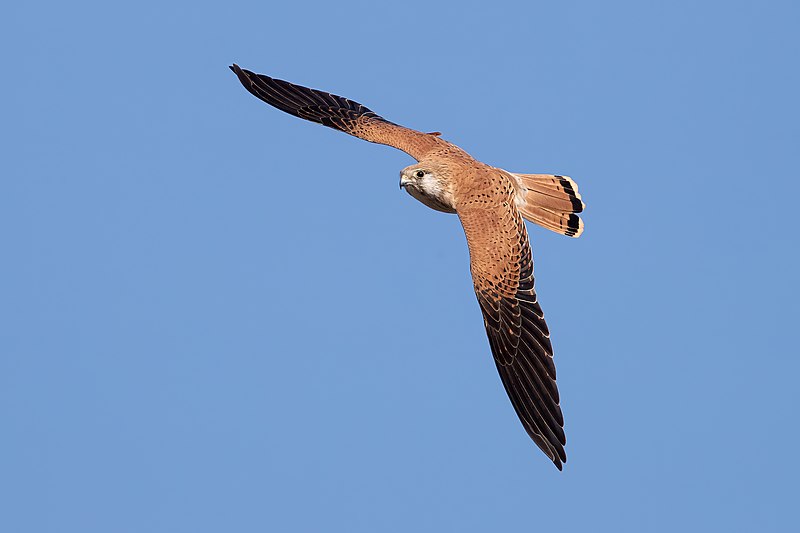
The nankeen kestrel is a small bird of prey native to Australia and New Guinea. Unlike many raptors, it does not rely on speed to capture its prey; instead, it perches in an exposed spot or hovers over fields and grasslands.
It belongs to the genus Falco which also includes other species such as peregrine falcons.
This bird typically has cinnamon-brown upperparts with dark wings and tail whilst its underside is usually pale buffish-white colouring with narrow black barring across the chest area.
Its diet consists mainly of insects but can include reptiles, amphibians, mice and even some birds among others depending on their availability within their habitat range.
The Nankeen Kestrel is an important part of our ecosystems providing essential services such as pest control for farmers by preying upon pests like locusts while also being a keystone species that influences surrounding habitats through predation or competition for resources amongst other animals.Scientific classification:
| Kingdom | Animalia |
| Phylum | Chordata |
| Class | Aves |
| Order | Falconiformes |
| Family | Falconidae |
| Genus | Falco |
| Species | F. cenchroides |
Also Featured In: Christmas Island Birds, Birds of King Island
38. Silver Gull
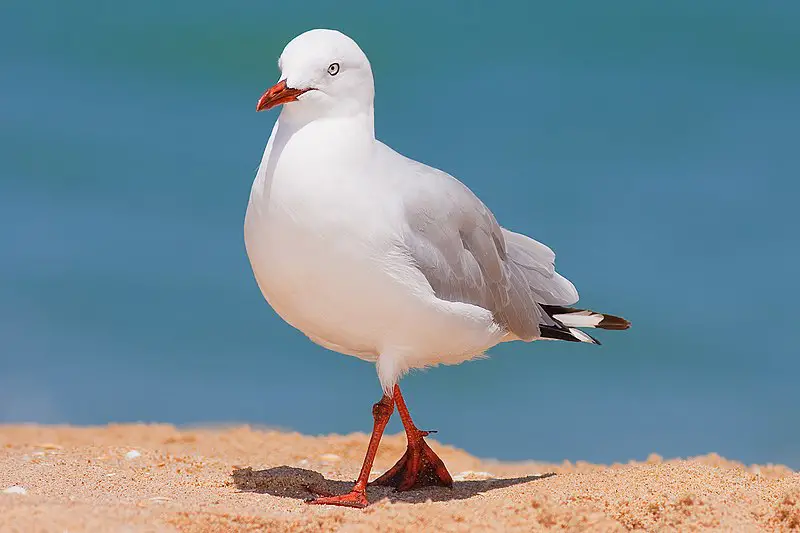
The Silver Gull is a common sight in Australia, especially along the coastlines. It’s smaller than the Pacific Gull and has silver-grey wings with white head and underparts.
Its scientific name is Chroicocephalus novaehollandiae, but it shouldn’t be confused with the Herring Gull which is also called “Silver Gull” in many other languages (Larus argentatus).
During summer months these birds can often be seen around fishing boats scavenging for discarded food or flying low over city parks looking for handouts from humans.
They are highly adaptable to their environment making them quite successful at coexisting near human populations.
These Australian seabirds have been known to live up to 25 years old.Scientific classification:
| Kingdom | Animalia |
| Phylum | Chordata |
| Class | Aves |
| Order | Charadriiformes |
| Family | Laridae |
| Genus | Chroicocephalus |
| Species | C. novaehollandiae |
Also Featured In: Gulls Species, Birds that Live around Brisbane
39. Sacred Kingfisher
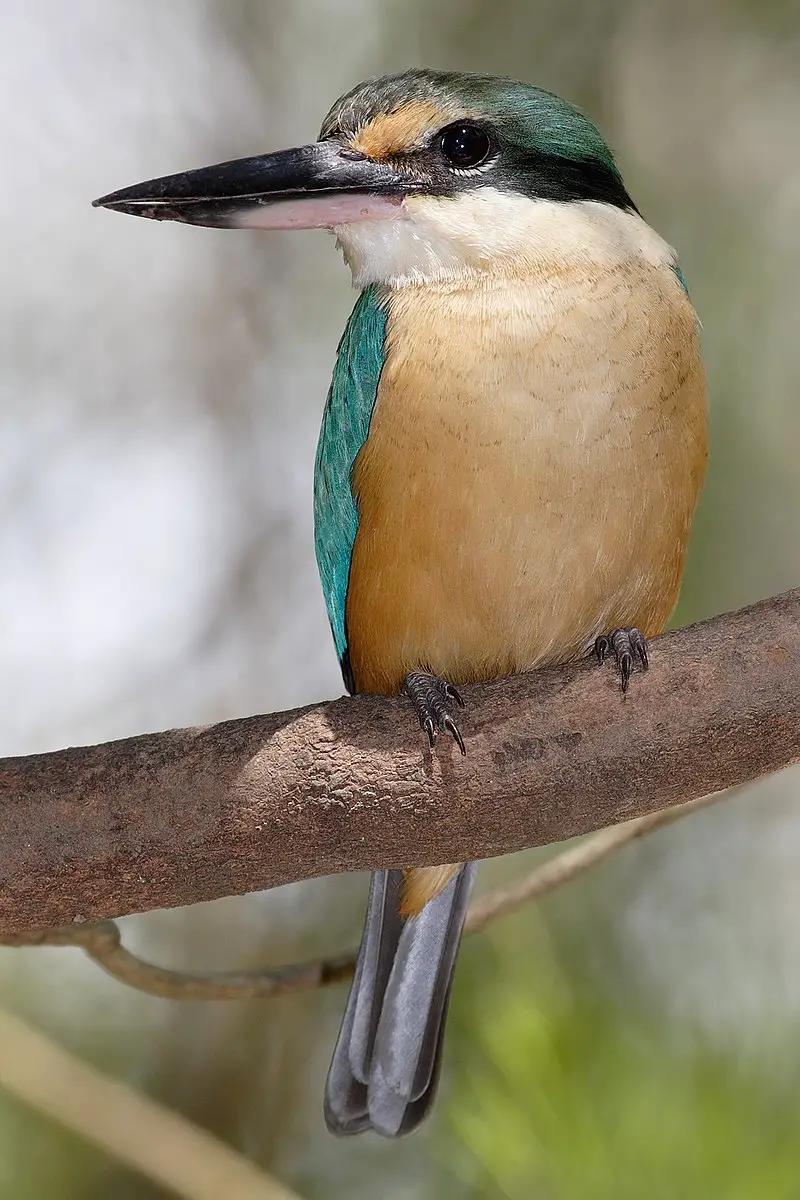
The Sacred Kingfisher is a medium-sized bird found throughout Australia, New Zealand and the western Pacific. It inhabits mangroves, woodlands, forests and river valleys.
Its binomial name Halcyon sanctus was introduced by Nicholas Aylward Vigors and Thomas Horsfield in 1827 when they described an Australian specimen of this species.
The kingfisher has bright blue feathers on its back with striking orange or red underparts depending on their geographical location.
They feed mainly off fish but will also take crustaceans as well as other small aquatic prey like insects.
When breeding season arises these magnificent birds build elaborate nests out of mud pellets inside hollows near water sources making them one of the most unique avian creatures around.Scientific classification:
| Kingdom | Animalia |
| Phylum | Chordata |
| Class | Aves |
| Order | Coraciiformes |
| Family | Alcedinidae |
| Subfamily | Halcyoninae |
| Genus | Todiramphus |
| Species | T. sanctus |
Also Featured In: Kingfishers Species, Most Common Western Australia Birds
40. Glossy Black Cockatoo
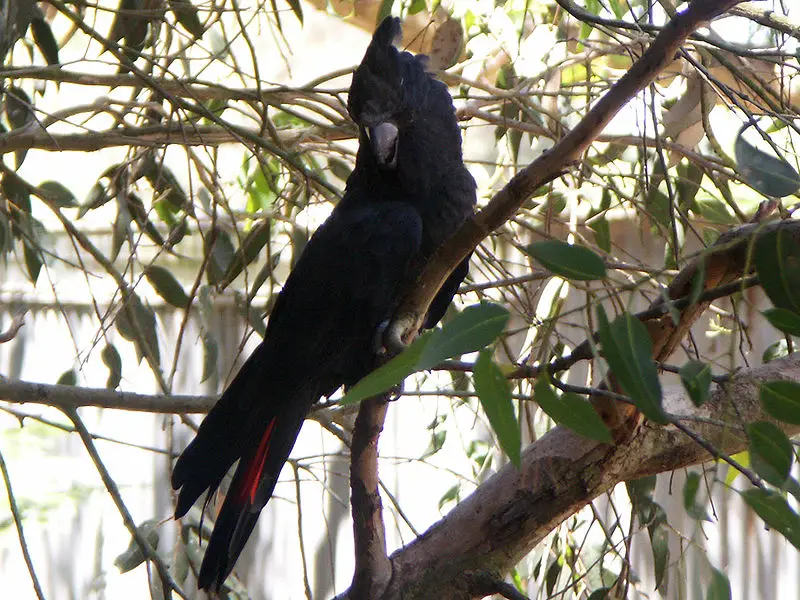
The Glossy Black Cockatoo is the smallest of its species and can be found in eastern Australia.
It has a length up to 50 cm, with males being blackish brown apart from their red tail bands, while females are dark-brown colored with some yellow spotting.
There are three recognized subspecies of this bird: Calyptorhynchus lathami lathami, C.l lroidoma and C.l semitorquatus.
They feed on seeds from native trees such as Eucalypts or Casuarinas but also forage for food near human settlements like farms or grasslands when natural resources become scarce during dry periods in summer time.
The male glossy black cockatoos have been known to make loud calls that echo through forests they inhabit which sound similar to machine gun fire.
Despite being listed as Near Threatened by IUCN Red List due to habitat destruction caused by logging activity, conservation efforts have been made aiming at preserving these magnificent birds so future generations can enjoy them too.Scientific classification:
| Kingdom | Animalia |
| Phylum | Chordata |
| Class | Aves |
| Order | Psittaciformes |
| Family | Cacatuidae |
| Genus | Calyptorhynchus |
| Species | C. lathami |
Also Featured In: Parrots Species, Birds that Live in Gold Coasts
41. Australasian Darter
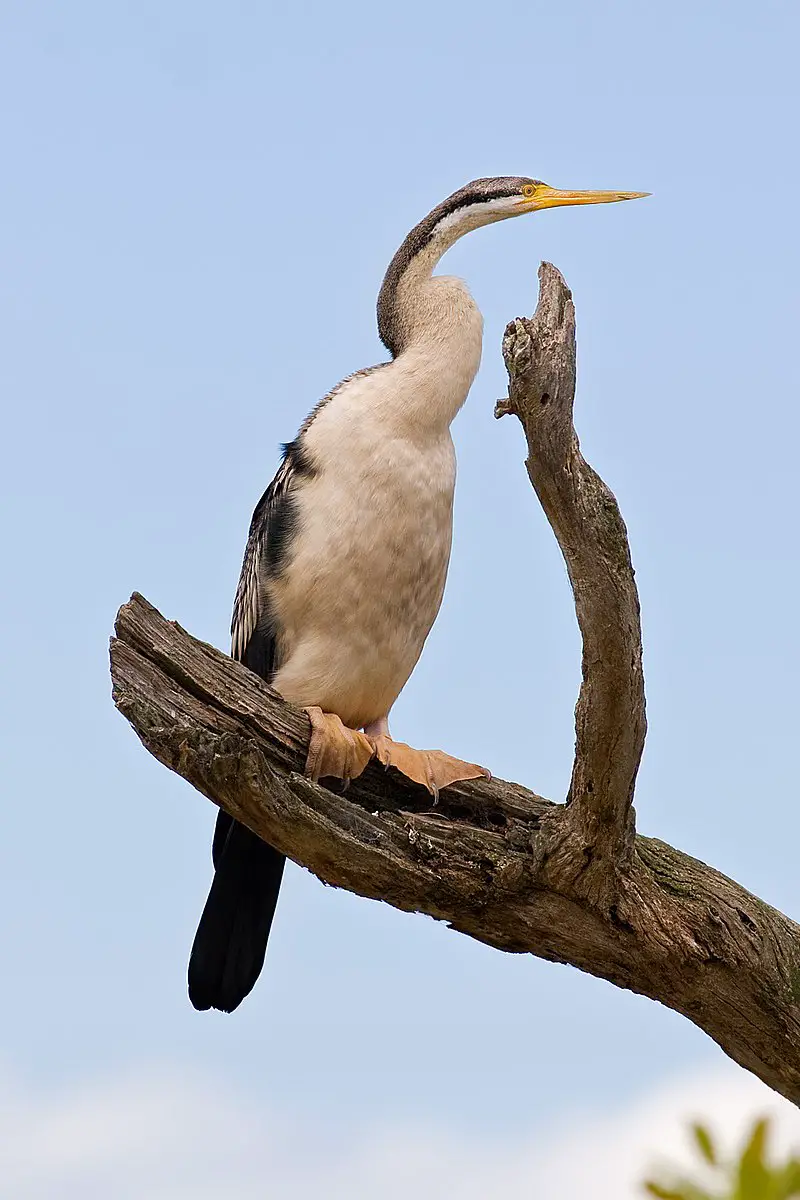
The Australasian Darter, also known as the Australian Darter, is a species of bird in the darter family. It can be found across Australia, Indonesia and Papua New Guinea.
This large bird has an impressive wingspan between 86-94 cm and weighs up to 2.6 kgs.
First discovered by John Gould in 1847, this long necked creature loves to swim and hunt for food underwater before drying its feathers on tree branches or rocks afterwards – like other Anhingidae species do.
They mainly feed on fish but will eat crustaceans too if they are around. With beautiful black plumage with white markings on their wings and tail these birds stand out from most others due to their unique style when it comes to fishing.Scientific classification:
| Kingdom | Animalia |
| Phylum | Chordata |
| Class | Aves |
| Order | Suliformes |
| Family | Anhingidae |
| Genus | Anhinga |
| Species | A. novaehollandiae |
Also Featured In: Cormorant Species, Birds that Found in Kakadu National Park
42. Powerful Owl
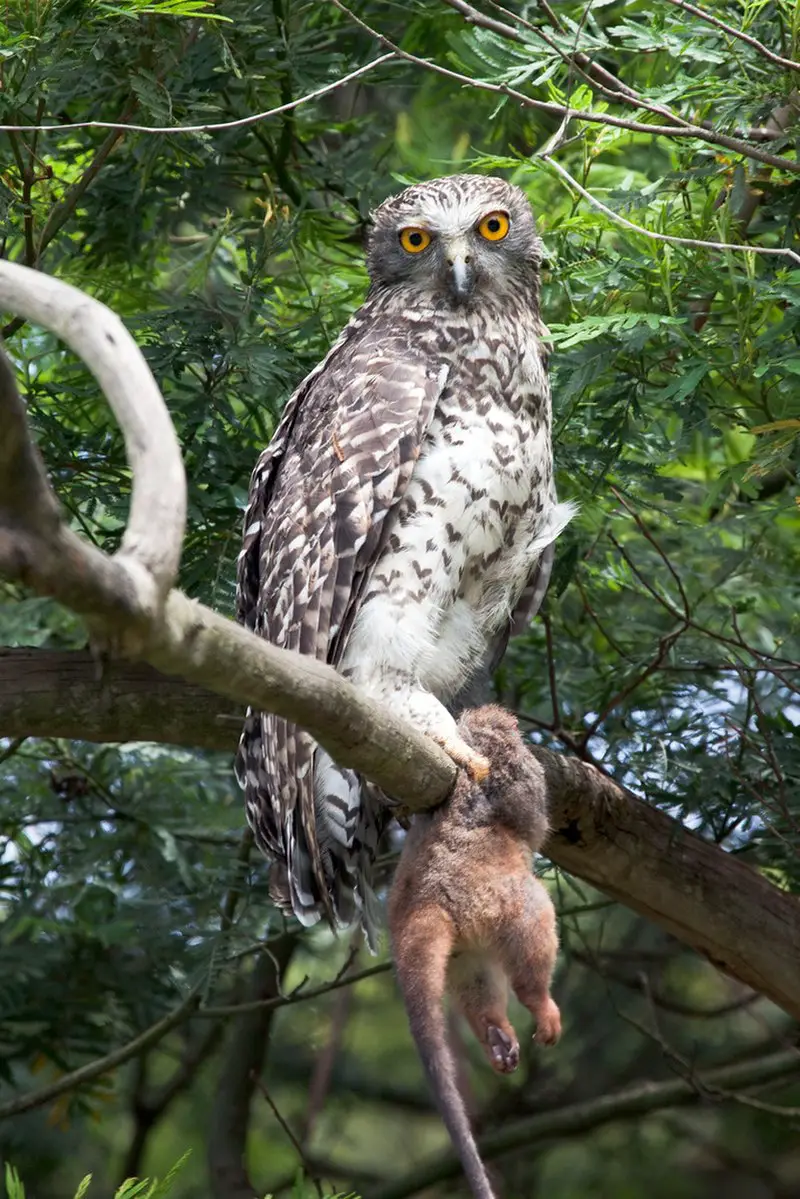
The Powerful Owl, also known as the Powerful Boobook, is the largest owl species in Australia. It can be found in both coastal areas and the Great Dividing Range, though it is rarely found more than 120 miles inland.
These owls are apex predators in their region, hunting a variety of prey. Due to habitat loss, they are listed as a species of concern.
Despite this, they are still able to thrive in some urban areas as long as there is a stable food source available.
With their striking appearance and powerful talons, the Powerful Owl is a magnificent bird and an important part of the Australian ecosystem.Scientific classification:
| Kingdom | Animalia |
| Phylum | Chordata |
| Class | Aves |
| Order | Strigiformes |
| Family | Strigidae |
| Genus | Ninox |
| Species | N. strenua |
Also Featured In: Birds that Live around Victoria, Common Melbourne Birds
43. Australian White Ibis
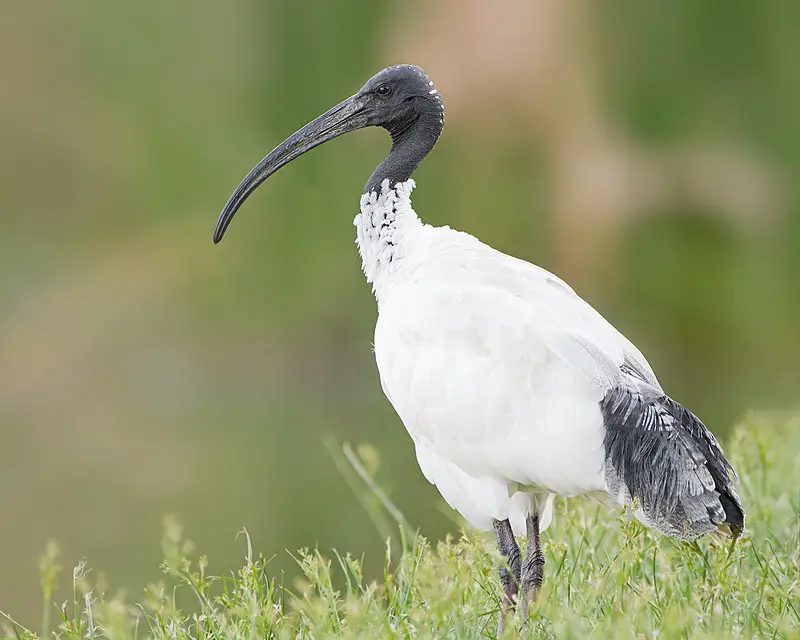
The Australian white ibis is a native wading bird of Australia. With its predominantly white plumage and long downcurved bill, it is easily recognized.
The bird is often found foraging for food on open grasslands, pastures and urban areas such as parks and gardens.
Despite being closely related to the African sacred ibis, the Australian white ibis is a separate species. It has a bare, black head and black legs.
The bird is well adapted to urban environments and often scavenges for food from waste bins or on streets.
While it has been subjected to negative perceptions due to its scavenging behavior, it remains an important member of the Australian ecosystem.Scientific classification:
| Kingdom | Animalia |
| Phylum | Chordata |
| Class | Aves |
| Order | Pelecaniformes |
| Family | Threskiornithidae |
| Genus | Threskiornis |
| Species | T. molucca |
Also Featured In: Water Birds Live around Us, South Australian Birds
44. Australasian Grebe
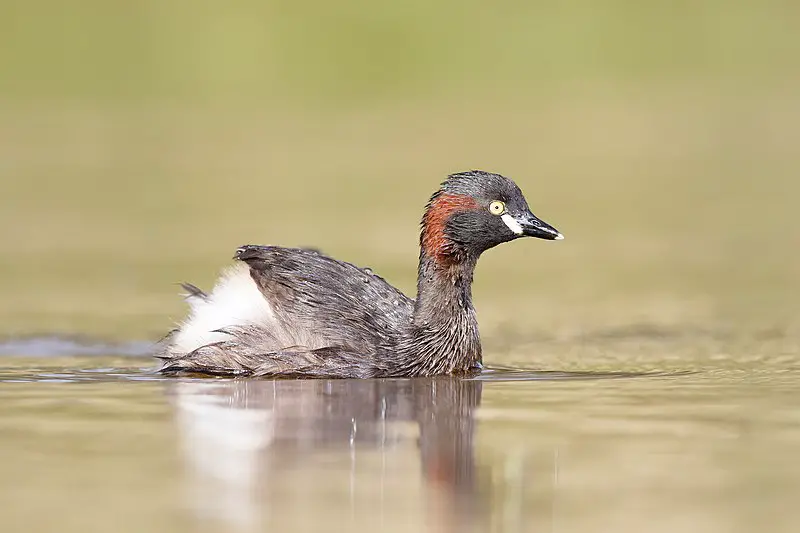
The Australasian grebe is a small waterbird that is frequently seen on fresh water lakes and rivers in Australia, New Zealand, and the Pacific islands. It is one of the smallest members of the grebe family, measuring only 25-27 cm in length.
The bird has a dark brown upper body and a glossy-black head and neck, making it quite striking in appearance.
Both male and female Australasian grebes look alike, and the species is known for its strong swimming and diving abilities.
Due to its reliance on freshwater ecosystems, the Australasian grebe is highly vulnerable to habitat loss and other environmental threats.
Conservation efforts are underway to protect this unique and important bird species.Scientific classification:
| Kingdom | Animalia |
| Phylum | Chordata |
| Class | Aves |
| Order | Podicipediformes |
| Family | Podicipedidae |
| Genus | Tachybaptus |
| Species | T. novaehollandiae |
Also Featured In: Birds of Tasmania, Birds that You’ll find in Perth
45. Pacific Black Duck
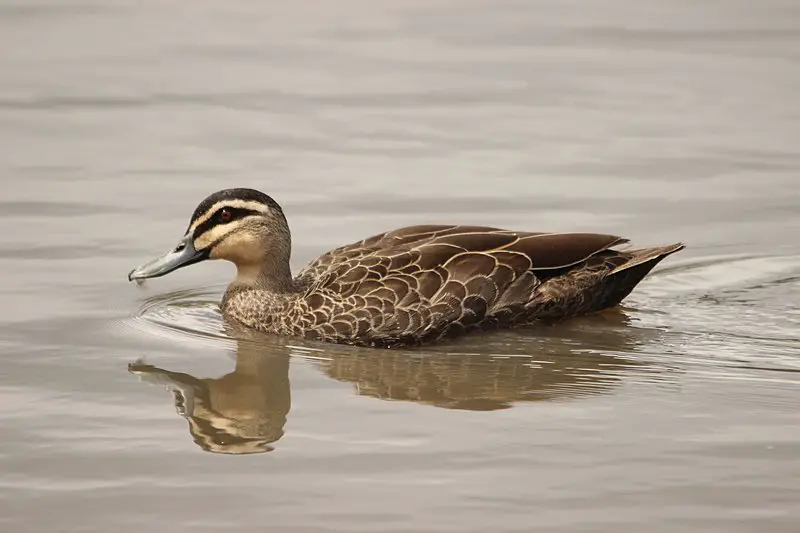
The Pacific black duck, also referred to as the gray duck in New Zealand, is a type of dabbling duck that can be found in numerous countries ranging from Indonesia to French Polynesia.
Its scientific name is Anas superciliosa. In New Zealand, the duck is often called by its Maori name, pārera.
The Pacific black duck lives in a variety of habitats, such as wetlands, marshes, and rice paddies.
It has distinctive features, including a dark body with white specks, a slightly curved beak, and a light-colored crown.
This duck is a common sight in its range, and it feeds on a variety of items such as insects, small fish, and seeds.
The Pacific black duck is an important part of the ecosystem and can even be hunted for food in some areas.Scientific classification:
| Kingdom | Animalia |
| Phylum | Chordata |
| Class | Aves |
| Order | Anseriformes |
| Family | Anatidae |
| Genus | Anas |
| Species | A. superciliosa |
Also Featured In: Sydney Birds You Need to See, New South Wales Birds You Need to See
46. Pale-Headed Rosella
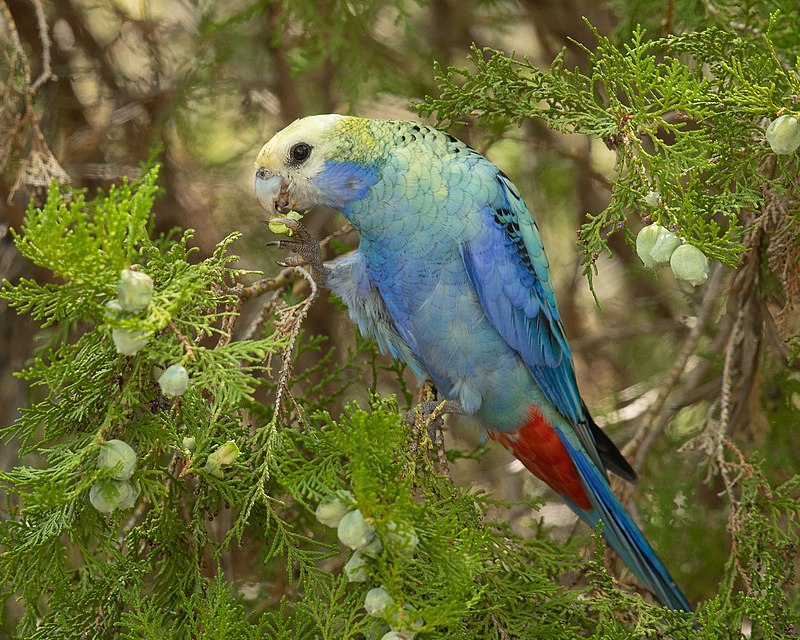
The Pale-headed rosella is a beautiful parrot found in northeastern Australia. This bird is a moderate-size parrot with a mostly pale yellow head, white cheeks, and blue underparts.
Its back is scalloped with black and gold, making it a stunning sight. While some experts consider it to be the same as the eastern rosella, two subspecies of the Pale-headed rosella are recognized.
These birds are known for their intelligence and are popular among bird lovers. They make excellent pets due to their affectionate nature, and with proper care, can live for up to 20 years.
In the wild, they feed on seeds, fruits, and insects, and can be found in open woodlands, forest edges, and urban areas.
Overall, the Pale-headed rosella is a delightful and fascinating bird to observe and interact with.Scientific classification:
| Kingdom | Animalia |
| Phylum | Chordata |
| Class | Aves |
| Order | Psittaciformes |
| Family | Psittaculidae |
| Genus | Platycercus |
| Species | P. adscitus |
Also Featured In: Birds that Live in Sunshine Coast,
47. Black-Shouldered Kite
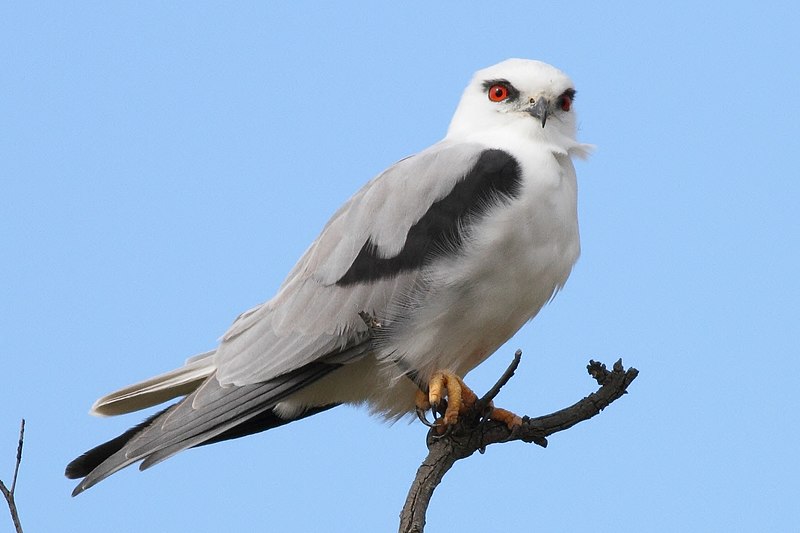
The Black-shouldered kite is a bird of prey that is found throughout Australia in open habitats. It is about 35 cm in length and has a wingspan of approximately 80 cm.
This species resembles others found in Africa, Eurasia, and North America. Despite its name, it is not closely related to the black-winged kite.
Instead, it belongs to the genus Elanus, which includes three other species.
The Black-shouldered kite has a distinctive pale grey head and body, with black shoulders and wings. It feeds mainly on small mammals, such as rodents and insects.
Although it is not considered threatened, habitat loss through land clearing and degradation poses a significant threat to its future existence.
This bird is an important part of Australia’s ecosystem and should be protected.Scientific classification:
| Kingdom | Animalia |
| Phylum | Chordata |
| Class | Aves |
| Order | Accipitriformes |
| Family | Accipitridae |
| Genus | Elanus |
| Species | E. axillaris |
48. Eastern Rosella
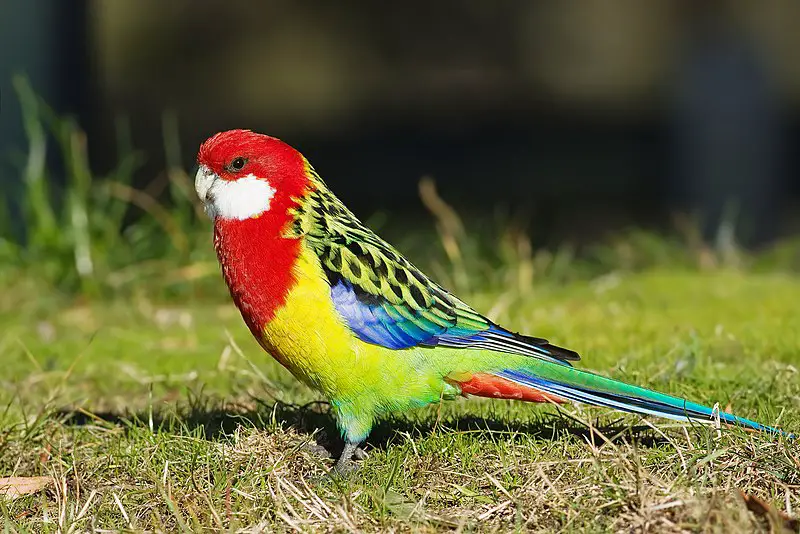
The Eastern Rosella bird is a native species of southeastern Australia and Tasmania. It has also been introduced to New Zealand and can be found in feral populations in the North Island and around Dunedin in the South Island.
The bird was first named by George Shaw. Eastern Rosellas are known for their colorful feathers, which generally include a bright red head, white cheeks, and yellow and green wings. They also have long tails and a distinctive beak shape.
These birds are typically found in wooded areas and have a varied diet that includes seeds, fruits, flowers, and insects.
Eastern Rosellas are known for their beautiful songs and are a favorite among birdwatchers and nature enthusiasts.Scientific classification:
| Kingdom | Animalia |
| Phylum | Chordata |
| Class | Aves |
| Order | Psittaciformes |
| Family | Psittaculidae |
| Genus | Platycercus |
| Species | P. eximius |
49. Scaly-Breasted Lorikeet
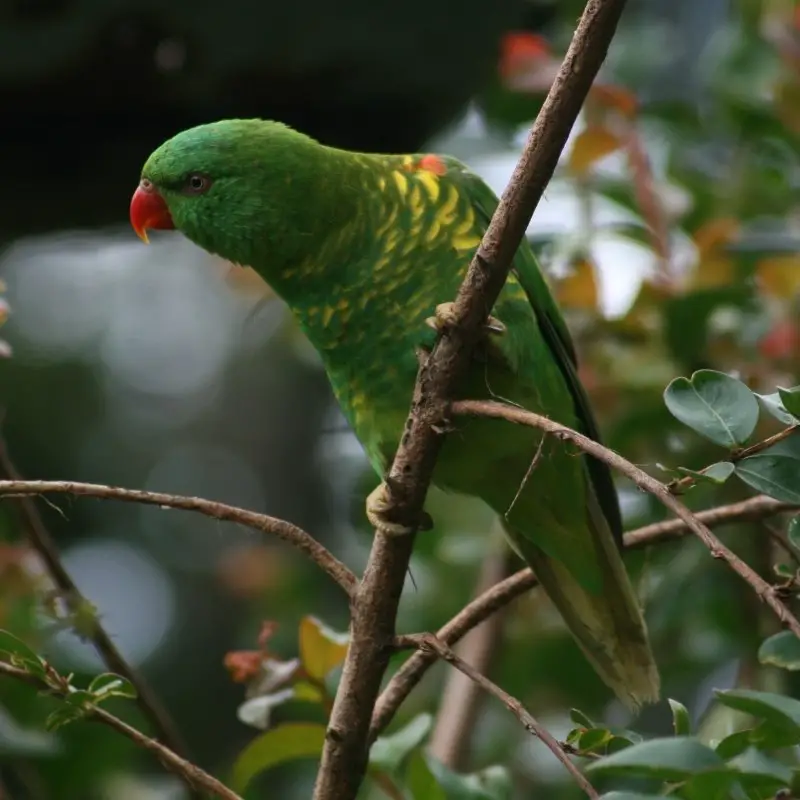
The Scaly-breasted lorikeet is a native Australian bird that can be found in woodland areas in the eastern region of the country.
Its unique name derives from the yellow feathers on its breast that are edged with a green scale-like pattern.
The bird was first described in 1820 by German zoologist Heinrich Kuhl.
In addition to its scientific name, it is also referred to as the gold and green lorikeet. It is known for its colorful appearance, which includes bright blue wings and a red beak.
The Scaly-breasted lorikeet is a social bird that is often seen in flocks or pairs.
It feeds primarily on nectar, pollen, and seeds, and can often be heard making a high-pitched screeching noise.
Due to habitat loss and other threats, the Scaly-breasted lorikeet is considered a species of least concern by the International Union for Conservation of Nature.Scientific classification:
| Kingdom | Animalia |
| Phylum | Chordata |
| Class | Aves |
| Order | Psittaciformes |
| Family | Psittaculidae |
| Genus | Trichoglossus |
| Species | T. chlorolepidotus |
50. Satin Bowerbird
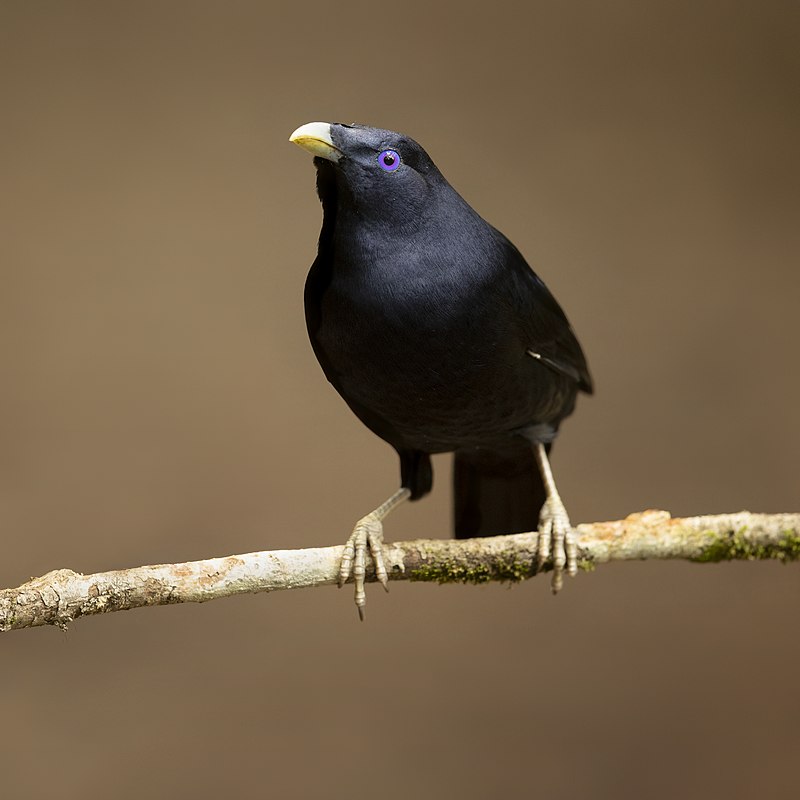
The Satin bowerbird is native to eastern Australia and is known for its distinctive appearance. The mature males of this species sport a black plumage and have unique violet-blue eyes.
Their feathers have a surface texture that causes light diffraction and gives the birds a beautiful metallic sheen.
Interestingly, a rare hybrid between the Satin bowerbird and the Regent bowerbird, known as Rawnsley’s bowerbird, has been observed in nature.
Satin bowerbirds are a type of bowerbird that build elaborate bowers to attract their mate. They use different materials and colors to decorate their bowers in order to impress females during the mating season.
This species is a fascinating example of the unique biodiversity found in Australia.Scientific classification:
| Kingdom | Animalia |
| Phylum | Chordata |
| Class | Aves |
| Order | Passeriformes |
| Family | Ptilonorhynchidae |
| Genus | Ptilonorhynchus Kuhl, 1820 |
| Species | P. violaceus |
51. Collared Sparrowhawk
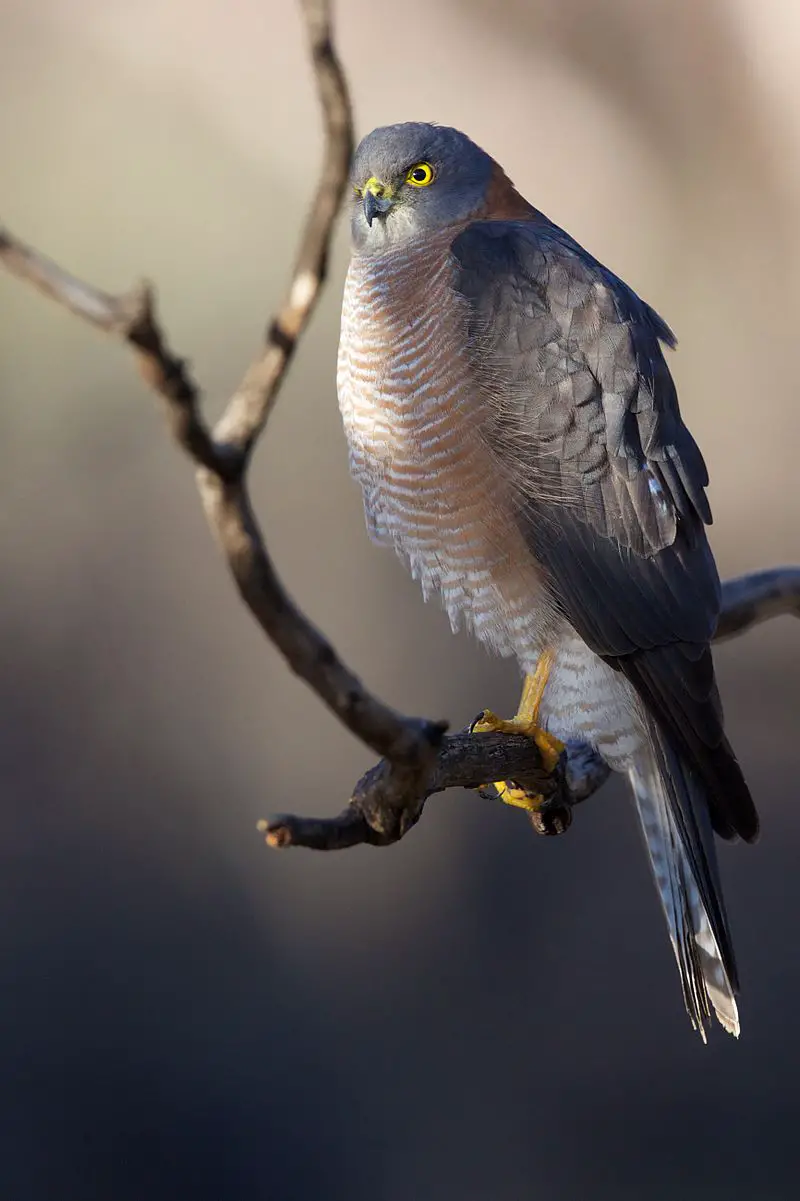
The Collared Sparrowhawk is a bird of prey that is found in Australia, New Guinea, and nearby islands.
It is known for its slender body and feet, with the last toe segment protruding beyond the others.
This hunter specializes in catching small birds, and is characterized by its slight brow ridges.
Despite its small size, the Collared Sparrowhawk is an efficient predator, using its skill and sharp talons to catch prey in mid-air.
Its golden eyes are always scanning the horizon for potential meals, and it uses its powerful wings to move swiftly and silently through the trees.
The Collared Sparrowhawk is an impressive bird that is greatly admired for its agility and hunting abilities.Scientific classification:
| Kingdom | Animalia |
| Phylum | Chordata |
| Class | Aves |
| Order | Accipitriformes |
| Family | Accipitridae |
| Genus | Accipiter |
| Species | A. cirrocephalus |